Commonwealth use in NW Europe
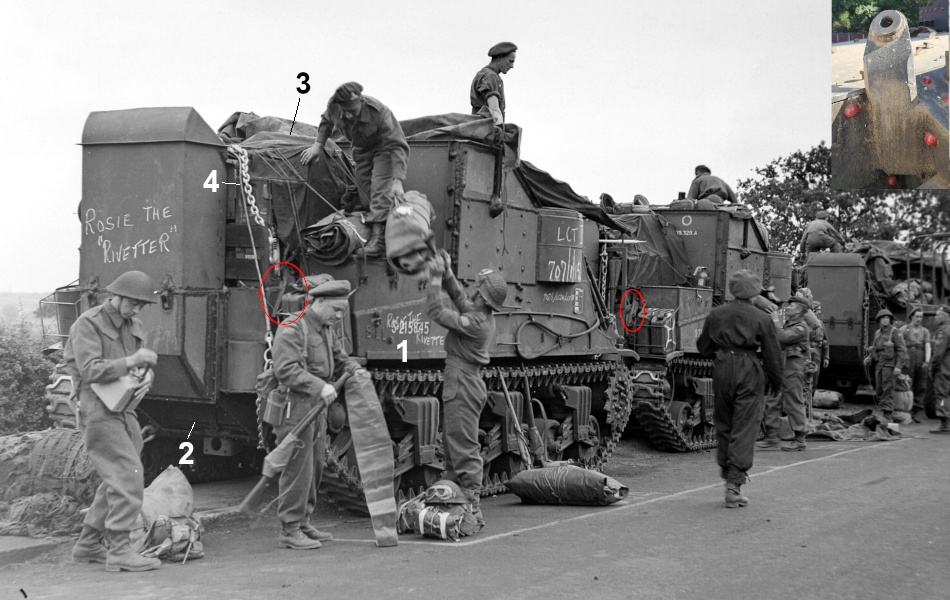
For the D-Day landings, the British and Canadians had determined that all of the artillery of the initial assault would be self-propelled. One report has it that aside from the SP's mobility, "the ability to fire from landing craft and to land with the gun pointing at the enemy was considered important." For reasons of supply and maintenance, the British Army wanted to standardize on the Sexton 25 pounder Self Propelled Gun and we can only assume that M7s were used on D-Day simply because sufficient supplies of Sexton IIs were not yet available. To that end, the Canadians deployed four Field Regiments which were temporarily equipped with M7 Priests for the assault landings at Juno Beach. The 12th, 13th and 14th were organic to the 3rd Canadian Infantry Division, while the 19th was a First Canadian Army asset that was attached so that both of the infantry brigades in the initial assault could be supported by two self-propelled Field Regiments. The photo shows a trio of M7s of F Troop, 14th Cdn FR preparing to load onto their LCT [Landing Craft, Tank] in Southampton on or about 1 June 1944. "Rosie The Rivetter" can be seen as S-215845 (1). These Priests have been installed with the many fittings that made up the British "Long Immersion" wading kit specifically tailored to the M7. The removable panel (2) at the bottom of the wading trunk is not present. This was one of the last items installed to complete the waterproofing, since the opening permitted the engine exhaust to flow down and out right up until the last minute. The M7s are piled high with "gear" (3). According to an account by Sgt. Wesley Alkenbrack entitled "A First Deployment of the 14th Field Regiment, Royal Canadian Artillery", "On the rear decks over the motor compartments were lashed canvas-covered cases four feet high containing mortar bombs and land mines for the use of other arms. It is frighteningly obvious that our SPs were highly lethal bombs if we encountered enemy fire before we could rid ourselves of these impediments." The large chains (4) secured a "Porpoise Ammunition Sledge" to each M7. Sgt. Alkenbrack describes it..."Slung between our tracks and secured by clevises to the front corners of the chassis was a wide steel “stone boat” about sixteen inches high, containing .303 rifle ammunition for the use of the infantry. While this grotesque device gave no great difficulty as long as the vehicle was moving straight ahead, backing up could be difficult and a sharp turn of the vehicle was virtually impossible." We have circled retrofitted items that do not seem to have been part of the "Long Immersion" kit but are seen in a few photos of Canadian M7s in the UK before D-Day and on a few Commonwealth Priests in the ETO. We had noticed these in some period photos of M3 Grants in the China-Burma-India Theater as well as on a pair of surviving examples (inset). In our Grant piece, we speculated that these fittings were retrofitted to a small number of M3 Mediums and served as rear lifting rings, since, unlike the Sherman, the M3 was not built with hull lifting rings. We speculated further that the towing lugs on the differential housing would have been used as front lifting rings. Since the M7 was not built with lifting rings, we would guess that they might have served the same purpose. While the fittings are seen welded into the corners on the Grants, they are noted to be mounted on a forward angle and secured with bolts on the M7s.
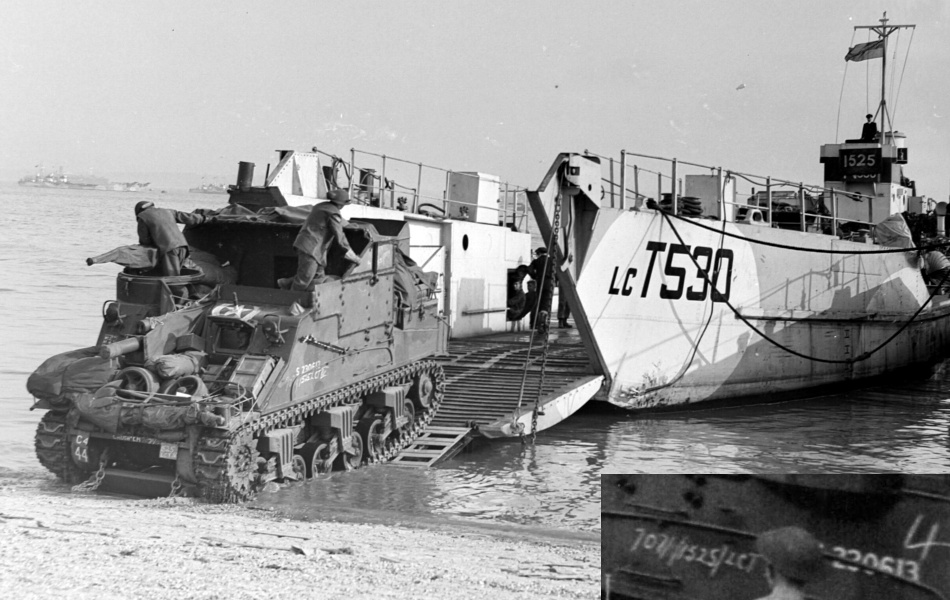
Canadian Field Regiments were organized along the lines of the British War Establishment, and consisted of three Batteries, with each Battery composed of two Troops of four guns, for a total of 24 M7s. On D-Day, these were reportedly embarked by Troop (four guns) on 6 LCTs. The War Diary of the 14th FR mentions that their craft load serials were "1523 - [15]29, which consisted of 1 Regt HQ craft and six tp [troop] craft loads." The photo above shows M7 "C4", backing on to LCT 530 in preparation for the D-Day assault. Combining this with another photo in the series, we take the M7's War Department Number to have been S 230613 (inset). We have recorded 43 listings of M7s in a range running from S 230472 through S 230649, so encompassing about 177 units at present. This is the highest range of "S Numbers" we have observed on M7s. Note that "1525/LCT" is visible in the inset, and that "1525" can also be seen on the LCT's bridge. According to the very detailed Juno Beach Landing Table published on "D-Day: Etat Des Lieux", Serial 1525 was LCT MkIV 530 carrying a Troop of 48 men of the 14th Canadian Field Regiment manning four M7s, two Sherman OPs [Observation Posts], one Carrier OP and one M14 Halftrack. Additionally, Serial 1525 reportedly transported 4 men of Le Régiment de la Chaudière in a mortar carrier, 9 men of the Queens Own Rifles of Canada in three Carriers, 3 men of the Canadian Press Relations Service, and 2 men of the Royal Navy Command in an Amphibious Jeep. The chained item below the differential housing is the aforementioned "Porpoise Ammunition Sledge". Courtesy Library and Archives Canada: Negative No. 33587.
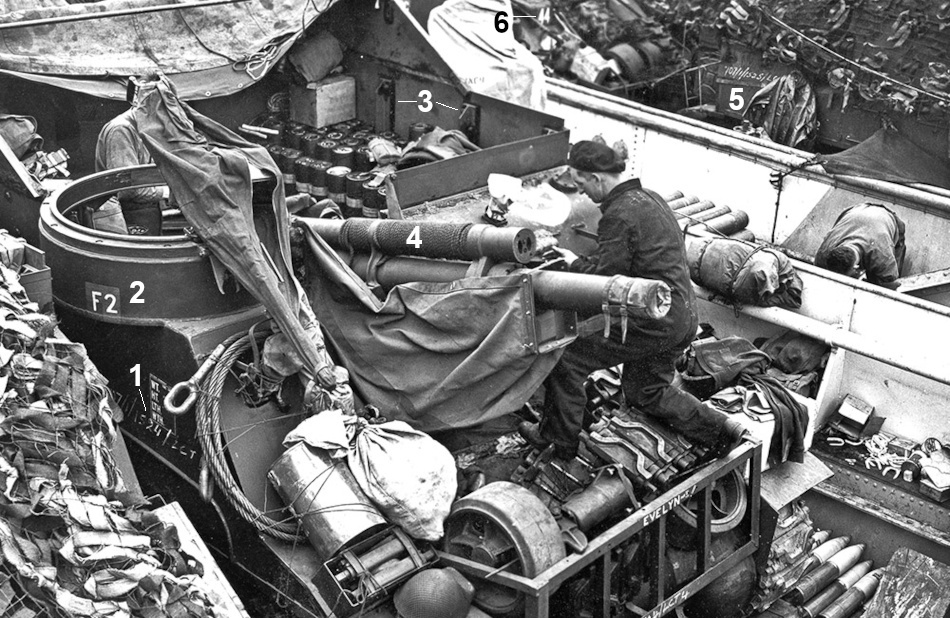
This photo shows "Evelyn-5!" loaded aboard an LCT at Southampton on 4 June 1944. The "1524/LCT" (1) seen chalked or painted on would indicate that this was a Priest of the 14th Field Regiment that was transported on LCT Load Serial 1524, which according to the Landing Tables was LCT Mk IV 885. The "F2" (2) signifies the second gun of F Troop, and the shaded quadrant it sits on indicates the 81st Field Battery (the third battery of the 14th FR). It can be noted that the left side "splash plate", Part No. US323A in the "Long Immersion" wading kit, was supported by stakes (3). The M7 can be seen carrying far more 105mm ammunition than normal, with rounds on the boat's deck as well, since it was planned that each M7 would fire "120 rpg" [rounds per gun] on the way in. Of interest is that the gun's recuperator housing is wound with hemp rope (4). This is frequently seen on Commonwealth Priests and was first done by the Brits in North Africa, because it was felt that the housing was vulnerable to shrapnel damage. "F2" is one of the few M7s in this series noted with a shallow pulpit. The Priest loaded on the LCT in the background can be seen with "1525/LCT" (5) which, from the previous caption, we take to mean that it is loaded aboard LCT 530. The Sherman tank just behind it has Unit Serial Number "44" (6) painted on the bow gunner's hood. This can also be seen on "C4" in the photo of the previous caption, and we take it to be the USN of the 14th Canadian Field Regiment. Courtesy of Canadian Department of National Defence / National Archives of Canada / PA-191019.
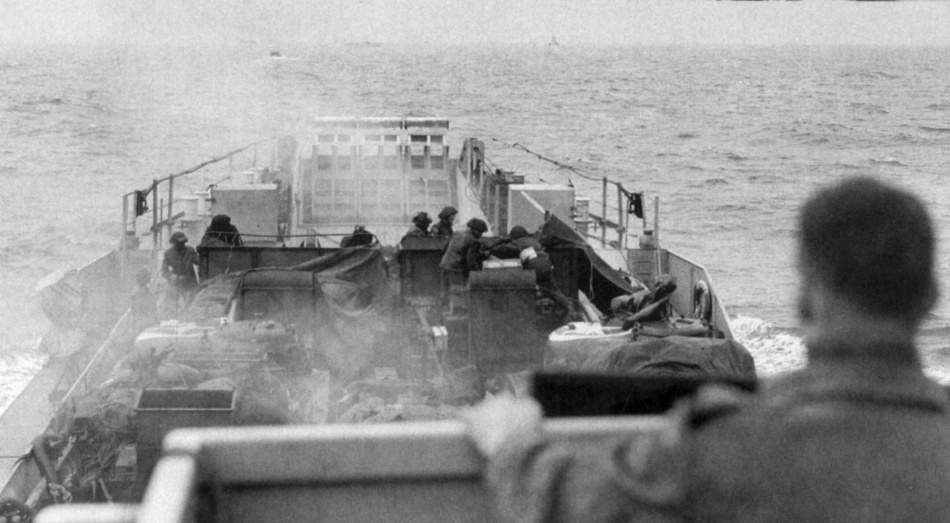
The assaulting SP units had trained beforehand and actually did provide "naval support" on the way in. As mentioned, in the case of the Canadians, each of the 96 M7s was provided with an extra 120 rounds to fire from their LCTs. In a post war study, it was found that the fire from the landing craft was not as effective as had been hoped..."the main weight of shells fell slightly inland of the strongpoints." Per the 14th Canadian Field Regiment, "The concentration was NOT as tight as had been obtained in some training exercises due to the running sea." The M7s of the 14th FR began landing on Juno Beach in support of the 8th Canadian Infantry Brigade, 3rd Cdn Inf. Div. at 0930 hours near Bernières-sur-Mer. According to their War Diary, by 1130 hours, they had set up their first gun positions "scattered in fields on right of Bernieres sur Mer 200 yards off beach." Of the 24 M7s that landed, 3 were hit and burned out by "a supposed 88mm", 3 were stuck in a traffic jam trying to exit the beach and 18 were in action. Assigned to the same sector, the 19th Army Field Regiment (SP) reported the loss of three M7s which had not yet disembarked from their LCT when one received a direct mortar hit which set it on fire and "the fire spread to two more S.P.s and a carrier." This may have had to do with the cases of "mortar bombs and land mines" loaded on the rear decks according to Sgt. Alkenbrack. In the event, D-Day losses had actually been expected to be much higher. For the landings at Sword Beach, the organic Field Regiments of the British 3rd Infantry Division, the 7th, 33rd and 76th, were each equipped with 24 M7s. So, it would seem, a total of 168 M7s were deployed by the Commonwealth on 6th June. Some Sextons did take part in the assault on Gold Beach in support of the British 50th Infantry Division and the 86th, 90th and 147th Field Regiments (SP) were reported to have been equipped with 24 Sextons each. The photo above is credited to Lt. Frank L. Dubervill of the Canadian Army Film and Photo Unit and is dated 6 June 1944 with the header "First Beach Landings in Normandy." Lt. Dubervill appears to have taken this shot while aboard an LCT headed for shore on D-Day. There are two Priests in the front row with two Shermans behind them and possibly a smaller vehicle in between the Shermans. From the Landing Tables, it would seem that a typical load of an LCT carrying a Troop of a Canadian Field Regiment on D-Day consisted of 4 M7s, 2 Sherman OPs, 1 Carrier OP, an M14 Halftrack, and 5 or 6 more Carriers or Jeeps belonging to other units. Thus, we think that there are two other Priests out of shot on the tank deck directly behind the Shermans. Some reports mention that the SPs in the back row fired over the heads of the vehicles in front of them. Although there may be some smoke in the air, we suspect that the Priests had not yet begun firing when this photo was taken. On the other hand, the gunners appear to be busy doing...something. Courtesy of Canadian Department of National Defence / National Archives of Canada / Photo 33772.
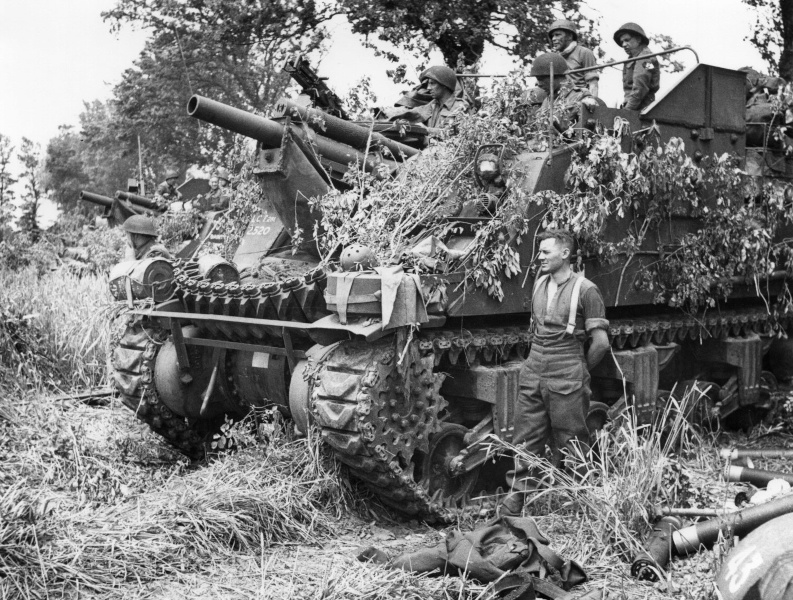
In "Reflections of an Artillery Officer", Captain Tony Turnbull of the 76th Highland Field Regiment, describes his experiences at Sword Beach on D-Day. He confirms that his unit was equipped with "American 105 mm mounted on Sherman tank chassis" and that, as with the Canadians, "Two of the guns were at the front of the craft on a well deck and two were at the rear of the well deck with two Sherman tanks between each pair." The 72 guns of the 7th, 33rd and 76th Field Regiments "started firing from their LCTs at 06.50 hours and continued for the next 35 minutes." H-Hour at Sword Beach was 0730 and the 76th was the first of the 3 Field Regiments to touch down at between 0835 and 0845 hours. The landings were made under fire, and Batteries 302 and 303 each lost 3 M7s while Battery 454 was able to deploy all eight of its guns intact. Capt. Turnbull relates, "We spent about five hours firing from the beach, which was becoming narrower as the tide came in, but we were the only guns that could support the British 6th Airborne Division at Pegasus Bridge at that time." We might mention here that the range of the M7 was about 7 miles and Pegasus Bridge was about 6 miles from Sword Beach. All of the beach exits could not be cleared immediately, so that supporting armor, etc. piled up in a few bottlenecks. Turnbull writes, "We did eventually leave the beach in the afternoon when sufficient paths had been cleared through the minefields." The Imperial War Museum photo above is one of the few that shows a British M7 on D-Day. The caption reads, "105 m.m. self-propelled guns in action by the side of a field. Location said to be Lion-sur-Mer." Based on the Unit Serial Number "43" seen on the fender of the vehicle in the photo's bottom right corner, the Priests were most likely of the 33rd Field Regiment. In addition, a close examination of the markings on the M7 shows "LCT 281" with "2520" just below. D-Day researcher Michel Sabarly informed us that "‘2520’ was the "Unit Mobilization Serial Number" for 33 Fd Regt" and that LCT 281 carried D Troop. In the photo, directly above the second POL can, it can be seen that the name "Dainty", indicative of D Troop, is just visible on the M7 in the background. According to an official Landing Table, LCT serials 278 through 283 were assigned to transport the 33rd FR. In his book, "D-Day Gunners", author and Normandy tour guide Frank Baldwin has a stop on his tour just outside of Hermanville-sur-Mer, which he writes "is probably the location of a widely published photograph of 33rd Field Regiment Priest SP Guns on D-Day." If accurate, the photo would have been taken in the afternoon of 6 June after the unit had managed to squeeze through a beach exit. The "Long Immersion" manual advised the removal of the wading trunk and air intake sealants as soon as possible upon landing to avoid overheating which could lead to engine damage or fire. It is thought that the Field Regiments did not have time for this on D-Day. In this case, the kit's "canvas apron for howitzer aperture" has been unsealed so that the gun can elevate and traverse, but it has not been fully removed. Also evident is that the kit's left hand side panels or "splash plates" are still in place, but the front and rear plates appear to have been removed. Again, we see the rope wound around the gun's recuperator housing. Imperial War Museum Photo B5032.
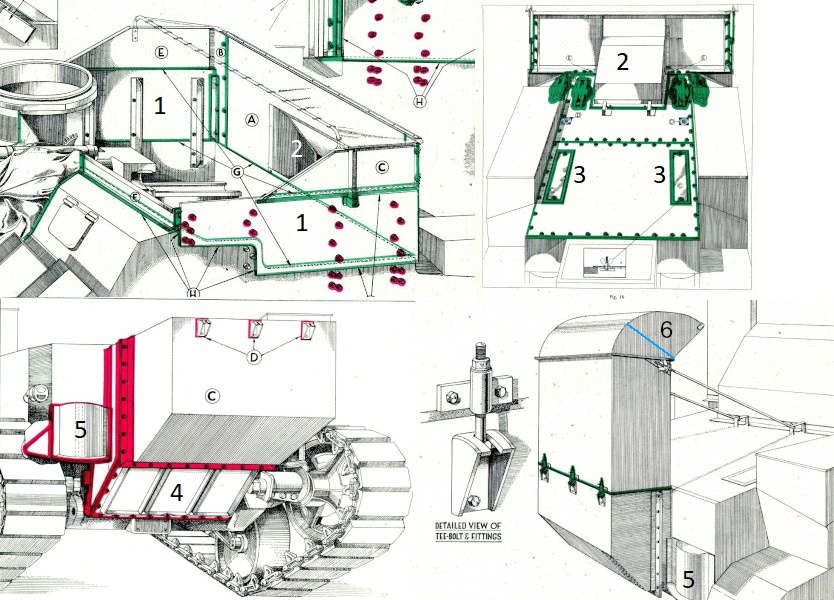
We thought we would show some illustrations from the January 1944 "Long Immersion" Manual since all of the British/Canadian M7s that landed on D-Day would have been so modified in order to permit them to wade "to a depth of 6 feet." In general, Allied invasion planners in all theaters provided for some form of "De-Waterproofing" station that would be set up as soon as possible after landing. The stations would be manned by trained personnel who could supervise the removal of wading components from both tactical and armored vehicles. This was primarily to prevent the engines from being damaged by overheating. In addition, the fittings were "supposed to be" collected up and saved for later use. The files of the Royal Canadian Artillery HQ, attached to the 3rd Canadian Infantry Division discuss the establishment of "transit areas" by H plus 5 hours. "In vehicle transit areas, phase "B" waterproofing will be removed (vehs can then run a maximum of 200 miles). Vehs will then be ordered to move to unit assembly areas." In their assembly areas, "Phase "A" waterproofing material will be removed as opportunity offers...Units will make every effort to salvage hardware." We can only assume that the removal of phase "B" waterproofing would have entailed anything that interfered with the free flow of air to and from the engine and anything that would interfere with the fighting capabilities of the vehicle. In any case, the four Canadian self-propelled Field Regiments were part of the assaulting waves at Juno and are reported to have conducted fire support missions right from the beach. They remained in continuous use for nearly 2 months and were likely not able to avail themselves of any "De-Waterproofing" services, except what their own crews could accomplish. Indeed, one crew report comments that the "de-waterproofing" process was just as arduous and time consuming as the waterproofing process. Period photos of Commonwealth Priests suggest that the kit's side panels or "splash plates" (1), were purposefully left on the vehicle and served as protection for the crew and the 105 mm rounds exposed in the fighting compartment. In many instances, these same plates are still seen on the M7s even after they were converted to Kangaroo Armoured Personnel Carriers. In fact, in a description of the APC conversion, it is noted that "Prior to this modification armour side plate had been installed up to the height of the cupola to afford added protection to personnel from enemy fire." The illustration in the upper right shows that in lieu of a forward wading trunk, air intake (2) was ducted through an opening in the rear splash panel of the fighting compartment. The "air outlet grilles" (3) were blanked off by kit provided steel plates. Note that the illustration does not show the M7's raised "grille protecting covers" nor does the manual mention them. Item 4 was removable and is referred to as the "rear cover panel." Items 5 sealed in the air cleaners and can be seen with a round bulge to them. Note the shape of the top section of the wading trunk (6). For some reason, this is frequently seen in period photos to have been cut in half along the line in blue.
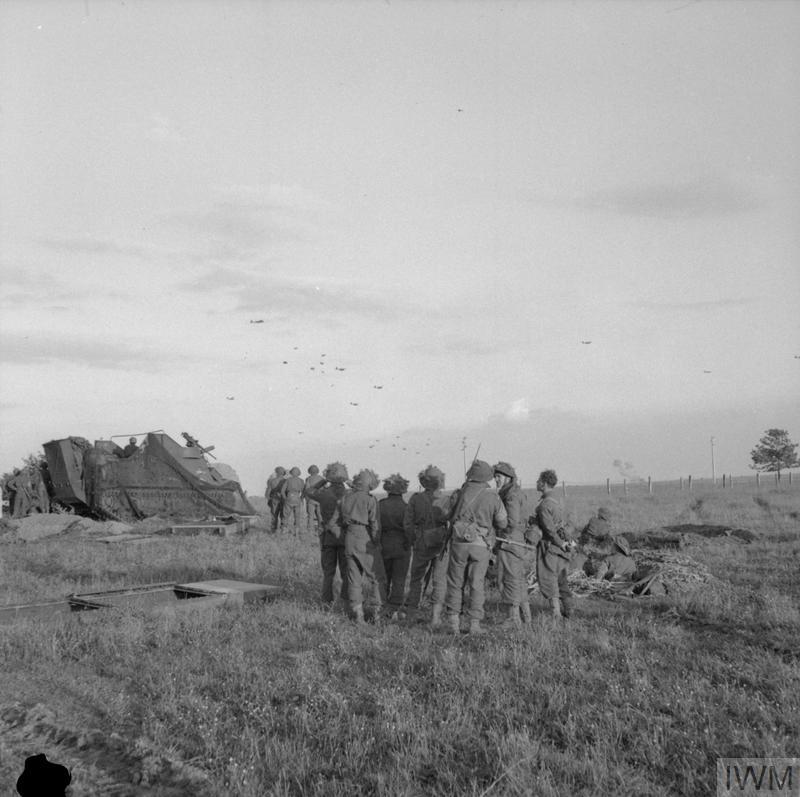
Here we have another IWM photo dated 6 June 1944. Like the previous image, this one is credited to "Sgt. Mapham." Sgt. James "Jimmy" Mapham served with the Number 5 Unit of the British Army's Film & Photographic Unit. He appears to have been one of the first still photographers to land on Sword Beach on D-Day, reportedly embedded with the 13th/18th Royal Hussars. Mapham took a photo of Tommies struggling ashore near Lion-sur-Mer on D-Day that the "American press" considered to be "the finest taken during the war." In "D-Day Gunners", there is another stop near Hermanville-sur-Mer that the author states is the location of the photo above. He identifies the Priest as one of "the guns of the 7th Field Regiment." It is thought that the aircraft in the photo would have been part of "Operation Mallard" the third and final Commonwealth airborne operation of D-Day. Around 2100 hours, [9 p.m.] the 6th Airlanding Brigade in 256 gliders overflew the landing beaches on the way to reinforce their brothers of the 6th Airborne Division fighting on the leftmost flank of the Allied beachhead. The "shallow pulpit" M7 is "still" installed with a wading trunk. The dark area seen at the bottom of the trunk suggests that the crew had taken off the removable panel to permit the engine exhaust to flow down and out. Note that the trunk is installed on an angle which is different from the vertical orientation seen in the few photos of Canadian M7s and shown in the "Long Immersion" Manual instructions. The side splash plates of the "Long Immersion" kit are still installed but the rear plate appears to have been removed. The history of the 33rd Field Regiment mentions that their Priests had been loaded "with that last minute hybrid the PORPOISE" but doesn't mention "canvas-covered cases four feet high containing mortar bombs and land mines" carried on the engine deck. In any case, there are two Porpoise sledges visible on the ground, so we might assume that some of the Priests managed to drag or otherwise transport them through a beach exit to this point. Their purpose appears to have been to provide ammunition resupply to the accompanying infantry, since a Royal Canadian Artillery file has it that each Porpoise would carry "15,000 rds .303 Bandolier." In the only effective counterattack on D-Day, elements of the 21st Panzer Division managed to penetrate the undefended seam between the British and Canadian sectors, and a few units made it all the way to the coast at Lion-sur-Mer. However, when the Division's commander saw the "Operation Mallard" aircraft fly over, he feared that their purpose was to cut off his forces from the rear and ordered a withdrawal back to the area north of the city of Caen. Thus, it seems, we have an example of unintended but successful Psychological Warfare. Imperial War Museum Photo B5046.
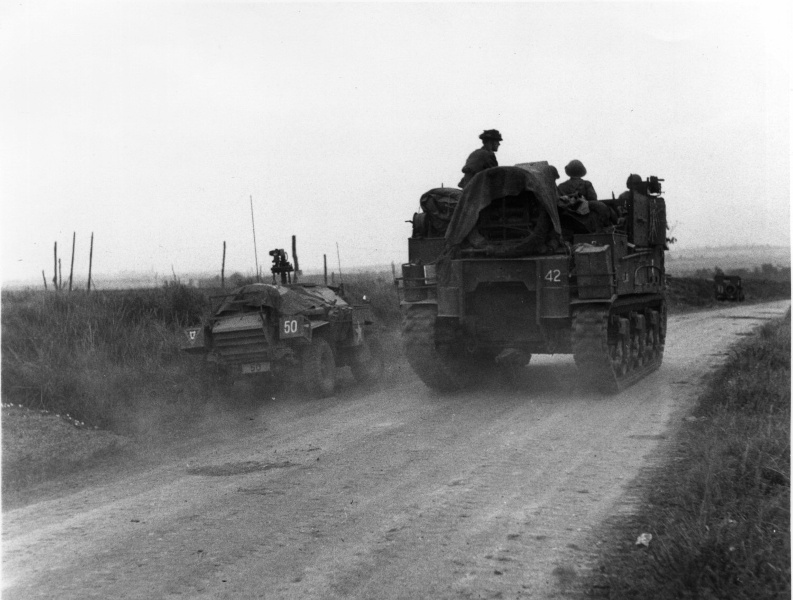
On D-Day, the planners had given the 3rd British Infantry Division the mission of securing the beachhead and then advancing to capture the city of Caen. While all of the Allied beaches were more or less secured by last light on 6 June, the 3rd ID was halted 4 miles (6.5 kilometers) short of Caen. In subsequent days and weeks, the Germans, who considered Caen to be the key to their defense, fiercely resisted the Allied attacks and committed most of their mobile divisions in the area. The photo above is dated 8 July 1944, and captioned, "Priest self propelled guns took part in the terrific artillery barrage which opened the attack on Caen. One is seen here dashing along the road to Caen after the attack had opened." Operation Charnwood was an offensive that took place on 8th and 9th July in which Anglo-Canadian forces were only able to capture that section of the devastated city north of the Orne River. The Germans still held fast to the southern half of Caen when the attack was suspended. We identify the M7 as with the 7th Field Regiment by the Unit Serial Number "42." The wading trunk can be seen to have been completely removed, although the support frames are still in place. Other photos from this series show M7s with the lowest section of the wading trunk still installed more than a month after D-Day. The half round fittings that sealed in the oil bath air cleaners are still present as well. It strikes us that leaving these on would make servicing the air cleaners difficult if not impossible. On the other hand, they might have provided a measure of shrapnel protection for the cleaners. The large right side splash plate from the "Long Immersion" kit is still installed, while the angled plate that sat on top has been removed as has the rear splash plate. This is the configuration most frequently seen on Commonwealth M7s in Normandy as well as the Kangaroo conversions. Given its ubiquity, we can't help but think that retention of the side splash panels was authorized. Imperial War Museum Photo B6655.
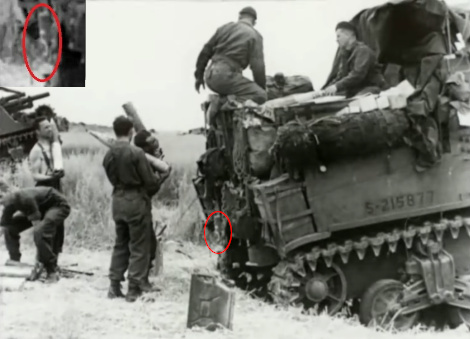
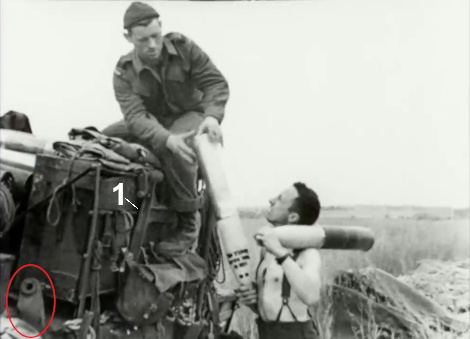
The screen captures above are from Canadian Army Newsreel, No. 35 and appear under the heading "Objective - Carpiquet." The newsreel is undated, but the scenes appear to have been shot on the 4th and 5th of July 1944 during "Operation Windsor" when elements of the 3rd Cdn Infantry Division and the 2nd Cdn Armoured Brigade were tasked with taking the town and airfield at Carpiquet. Like Caen, these were "only" 8 miles from the coast and had been D-Day objectives. The town of Carpiquet was cleared early on 4 July, but the operation failed to capture the airport. The newsreel features quite a bit of footage of artillery support provided by M7s, including a "ramped up" "S-215877" as seen on the left. The inset shows a "5" (circled) painted on the left-side half round wading fitting that sealed in the air cleaner. We suspect that this may be part of the "45" Unit Serial Number of the 19th Field Regiment, Royal Canadian Artillery. One of the disadvantages of the ammo protecting side plates, including leaving on the wading kit splash plates, was that they made it difficult to hand up rounds. In this case, the shells are being loaded from the rear. The screen capture on the right shows some of the same gunners handling rounds to be fired by S-215877. The man on the Priest can be seen with his right leg resting on a large crate. The crate looks to be secured to a metal rod framework, and to our eyes, what appears to be the M7 gun travel lock (1) can be seen attached to the top of the framework. This is not the only photo we have seen showing the travel lock stowed on the vehicle. For the first 6 weeks of the campaign, the M7s fired numerous missions but did not move very much, and when they did, it was for a short reposition to avoid counter-battery fire. "Technical Manual 9-731E 105-mm Howitzer Motor Carriage M7" advised that when the traveling lock bracket was not in use, it could be disengaged by lifting it out from the floor of the crew compartment and stowing it." Thus, we suspect that some crews removed the bracket to get it out of the way. The "eye" fitting (circled) shows very clearly here. The strategically important Carpiquet Airport was finally taken on 9 July during Operation Charnwood.
Commonwealth M7 "Kangaroos"
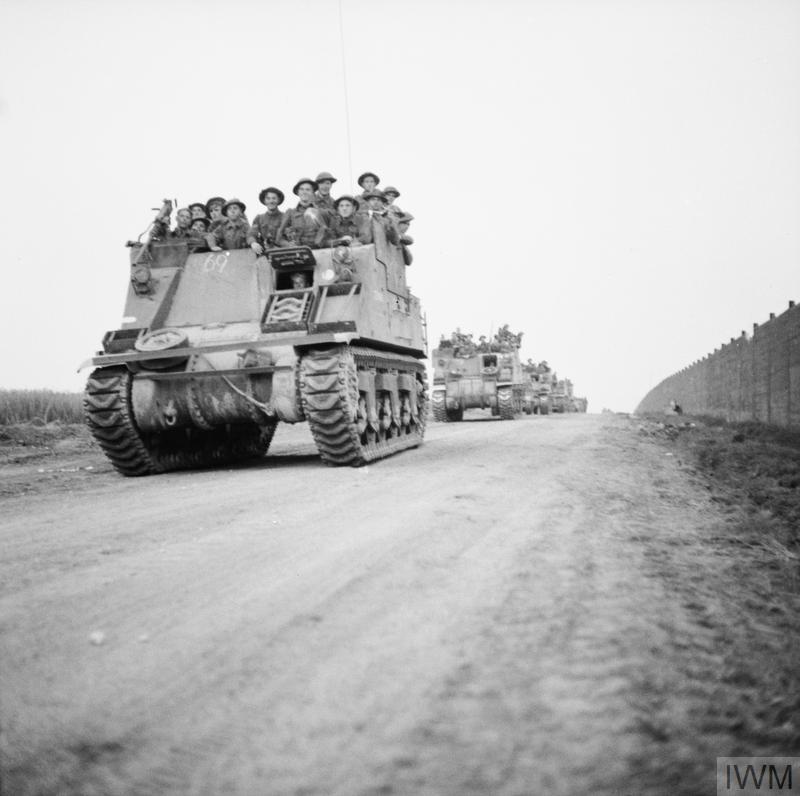
The British and Canadian M7s had been in continuous service since D-Day, but as mentioned previously, their use was a temporary measure. During the first week of August, the 12th, 13th and 14th Field Regiments of the 3rd Canadian Infantry Division reluctantly exchanged their Priests for towed 25 pounders. The Canadian 19th Field Regiment exchanged its M7s for Sextons on 24 August 1944. The British 33rd Field Regiment is reported to have exchanged its M7s for towed 25 pounders starting around 15 August. They also expressed regret at having to do so, and on top of that, their history mentions that their experienced Priest drivers were reassigned to other units that were desparately in need of qualified tank and SP gun drivers. We believe that the other Field Regiments of the 3rd British Infantry Division exchanged their M7s for towed 25 pounders at about the same time but can't document it at present. Because they were the earliest to be handed in, it would appear that most or all of the M7s of the 12th, 13th and 14th [Canadian] Field Regiments continued to serve in a new capacity as Armoured Personnel Carriers. For "Operation Totalize", Lt. General Guy Simonds, commander of the 2nd Canadian Corps ordered that "stripped Priests' chassis" be made available so "that infantry shall be carried in bullet and splinter-proof vehicles to their actual objectives.” To that end, an Advanced Workshop Detachment code-named "Kangaroo" was set up near Bayeux to convert 72 Priests to APCs. An entry in the War Diary of the Rear HQ, First Canadian Army describes the process. The pilot model was completed on Thursday 3rd August and sent to General Simonds for inspection and presumably met with his approval. Remarkably, by Sunday 6th August, 76 conversions had been completed. Each conversion required about 100-man hours. Of course, the gun was removed, but the trail was left in place. "Armour plate was then welded over the opening left when gun and mantlet were removed." The supply of armour plate was insufficient for all of the conversions so that some had "two sheets of mild steel (over 1/2" thick) ...welded into position about 1 1/2" to 2" apart and the intervening space was filled with sand." The seats and ammunition bins were removed but "The cupola with the .50 machine gun remained on the veh." "Operation Totalize" kicked off on the night of 7/8 August 1944, so this was a "hurry up" order. Even so, the project, which involved 250 men working 15 hours per day reportedly gave each vehicle "a complete overhaul" including transmission and brake service where needed. Sixteen engines required replacement and "Balance all had 100 hrs overhaul which involved removing engines." The photo above is dated 7 August 1944 and headlined "Preparing for the Attack South of Caen." The soldiers are identified in the caption as "1st Bn Black Watch, 51st Highland Division." In his fine article, "The ‘Priest’ Kangaroo Armoured Personnel Carrier, in Canadian Service, 7 August to 30 September 1944", Mark W. Tonner provides an alternate identification of the unit based on the markings chalked on the Kangaroo's gun blank off. He notes that "HD" the formation sign for "Highland Division" "is barely visible beside the number ‘69’." He describes "69" as the Arm-of-Service serial used by the 7th Battalion, Argyll and Sutherland Highlanders of the 154th Infantry Brigade within 51st Highland Division. Other sources have it that the AoS serial of the 1st Battalion, The Black Watch would have been "67." In any case, the 51st Highland Division was assigned to the 2nd Canadian Corps at the time. The 154th Infantry Brigade of the 51st HD and the 4th Infantry Brigade of the 2nd Canadian Infantry Division were chosen to lead the initial assault, and each brigade was provided with 36 Kangaroo APCs. Casualties in the "mounted" battalions were lighter than those suffered by units that went into the battle "marching", enough so that a new formation, the 1st Cdn. Armoured Personnel Carrier Squadron, was formed at the end of August. The M7 based Kangaroo APC was capable of carrying up to 15 fully equipped soldiers. We count 12 men in the photo, not including the driver. A number of the Kangaroo drivers employed were veterans of the Canadian Field Regiments that had exchanged their Priests for towed 25 pounders. Note how the large left side splash plate from the "Long Immersion" kit is still in place. Imperial War Museum Photo B8806.
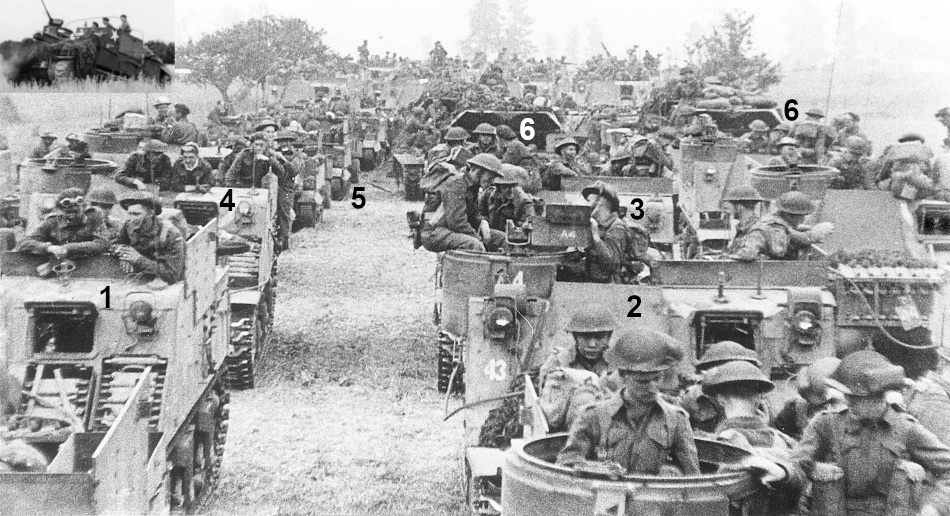
This photo is captioned "Infantry riding into battle in Priest Tanks, 4th [Cdn.] Infantry BDE (Brigade) - 2 Cdn. Div., France 7/8/44 [7 August 1944]." Kangaroos 1, 2 and 3 can be seen with what appears to be the front splash plate that was provided in the Long Immersion kit. Like the side and rear splash plates, this was designed for relatively easy removal so "that immediately on landing this plate can be discarded to allow normal forward vision." The front plate is not present on Kangaroo 4 nor on the two lead units of the previous photo. Thus, we might assume that it was not an element of the Kangaroo conversion process, despite the fact that it would have provided a bit of additional protection to the infantry riders. There is a bit of photographic evidence such as the example in the inset showing that some of the original M7 crews opted not to remove the front splash plate. Quite a few aerials are visible in the photo and a number of documents mention that about 60% of the APCs were installed with radios. A few universal carriers (5) can be seen, and it is noted that these and any available halftracks were used to supplement the carrying capacity of the Kangaroos. Note the turret counterweights of some M10 Tank Destroyers (6). The M10s may have been part of an anti-tank detail assigned to accompany the mounted infantry. Oddly, these units don't have the powerful .50 caliber machine gun mounted in the pulpit such as can be seen in the previous photo. At this time, the Priest Kangaroo had a crew of one, the driver. It was intended that one of the riders would man the machine gun. The first phase of Operation Totalize (the part that involved the Kangaroos) broke though the enemy defensive positions south of Caen. However, the armored units that followed up suffered great losses and were stopped by fierce German resistance 12 miles north of the operation's goal, Falaise, when the offensive was called off on 11 August. In the meantime, the US XV Corps was attacking north in anticipation of meeting the Canadians somewhere in the vicinity of Argentan. At that point, the German forces in Normandy would be completely encircled. Courtesy of Canadian Department of National Defence / National Archives of Canada / PA-129172.
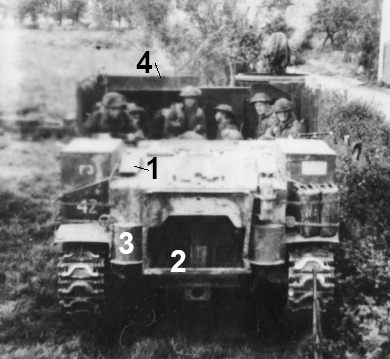
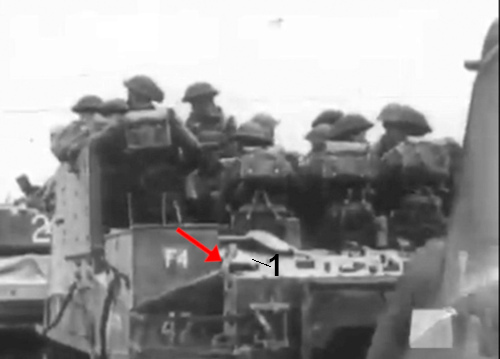
Operation Tractable (14 to 21 August 1944) was basically the second attempt to close the infamous Argentan-Falaise gap. It resulted in a decisive but controversial victory that, by some estimates, entrapped 150,000 German soldiers inside the "Falaise Pocket." The "Official History of the Canadian Army in the Second World War, Vol. III", identifies the 8th and 9th Canadian Infantry Brigades of the 3rd Cdn Infantry Division as the formations "using the armoured carriers" during the operation. On 14 August, the mounted brigades "again showed themselves extremely valuable" as they took their objectives on the Laison River on schedule, thus clearing the way for the armored forces to pass through. The 4th Cdn. Armoured Division was one of the units that passed through, and one of its components was the 10th Cdn Infantry Brigade. On 16 August, one of the 10th's Battalions, the Argyll and Sutherland Highlanders of Canada reported that "B Company was loaded on Priest Tanks." It is thought that the Argylls along with elements of the Lincoln and Welland Regiment took over some of the Kangaroos of the 8th Cdn Infantry Brigade and in conjunction with the 4th Cdn. Armoured Brigade and the 29th Armoured Reconnaissance Regiment (South Alberta Regiment) were involved in a number of the final battles which brought an end to the Normandy Campaign. The SAR War Diary for 19 August comments, "The help of the attd [attached] SP troop and their .50 calibre Brownings was invaluable" [at the Falaise Pocket]. As mentioned, the Priest Kangaroo had its combat debut on the night of 7/8 August 1944. Before that, a press conference was held on the morning of 7 August where walk around photos of the "Armd Inf Carrier" were shown. The image on the left was one of the photos presented and is of interest since it provides a view of the engine deck unfettered with the usual crew stowage. This M7 can be seen with the "deep pulpit" so it most certainly would have been built with the "grille protecting covers" raised about a foot over the "fuel tank compartment ventilating grilles." The "Long Immersion" instructions don't mention removing the covers, but that appears to have been done at least on these two examples. We can only guess that when these units were de-waterproofed, the kit supplied steel plates that sealed the ventilating grilles were removed and reinstalled spaced about 2 inches or so above the grilles (1). Either that or this was done during the APC conversion process. A good deal of the wading trunk frame is still in place on "F3", and we can't help but think that leaving on the lower section (2) would have made it difficult to open the engine access doors. As noted previously, during the conversion process, 16 engines were reported to have been replaced with the rest having a "100 hrs overhaul which involved removing engines." Again, we see that the "cans" (3) that sealed in the air cleaners were left in place. "F3" can also be seen to be one of the examples where the front splash plate (4) was left installed. The image on the right is a screen capture from Canadian Army Newsreel, No. 39 under the heading "Falaise Falls to the 1st Canadian Army." This Kangaroo can be seen as "F4" with the same Unit Serial Number "42" as "F3" suggesting that both M7s had previously served with F Troop of the 12th Cdn Field Regiment. The red arrow points to the fitting that we theorize was a retrofitted hoisting eye. We think that these are also present on "F3."
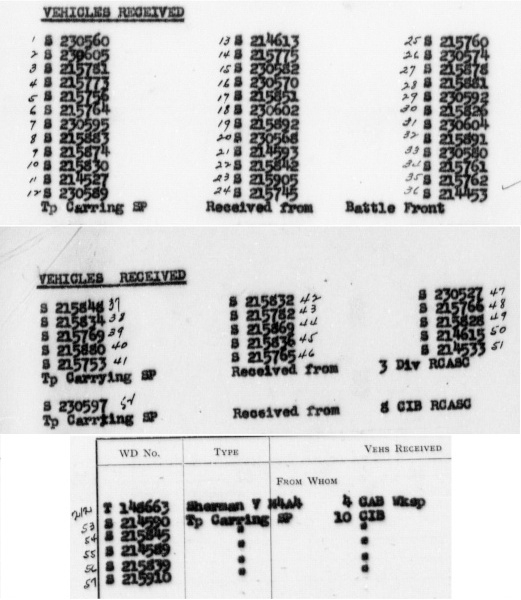
We like to record War Department Numbers for the purpose of "counting heads," and the 19 August 1944 "Daily Balance Sheet" for E Sqn, 25 Cdn Armoured Delivery Regiment (The Elgin Regt) notes the S-Numbers of 36 "Tp Carrying SP...Received from Battle Front." On the 21st, an additional 15 were received from the "3rd Div RCASC" [Royal Canadian Army Service Corps] along with one from the 8 Cdn Infantry Brigade RCASC. Finally, on the 22nd, 5 "Tp Carrying SP" were received from the 10th Cdn Infantry Brigade. Thus, we have a total of 57 M7 APC conversions turned in by units that had apparently used them during Operation Tractable. Keep in mind that 76 M7s were reported to have been converted to Kangaroos, but it is unclear at present what became of the remainder. On 21 August, the War Diary of HQ, 25 CADR mentions "a new attachment of personnel who will work as a taxi service for infantry following up the tanks in action." The Kangaroos had proven their worth and were rounded up so that an entirely new unit, the 1st Canadian Armoured Personnel Carrier Squadron could be organized. It was formed officially on 28 August 1944. The War Establishment was for 100 APCs in four troops each with 25 carriers. Captain Stanley Corbeau, a D-Day veteran of the 2nd Cdn Armoured Brigade, was appointed Officer Commanding. At full strength the Kangaroo Squadron would include four troop officers and 100 drivers, along with a Light Aid Detachment of about 30 men, organized especially to service the Kangaroos. In his "Priests at El Alamein," Peter Brown provides a list of the War Department Numbers assigned to M7s according to the official "Chilwell Schedules"...
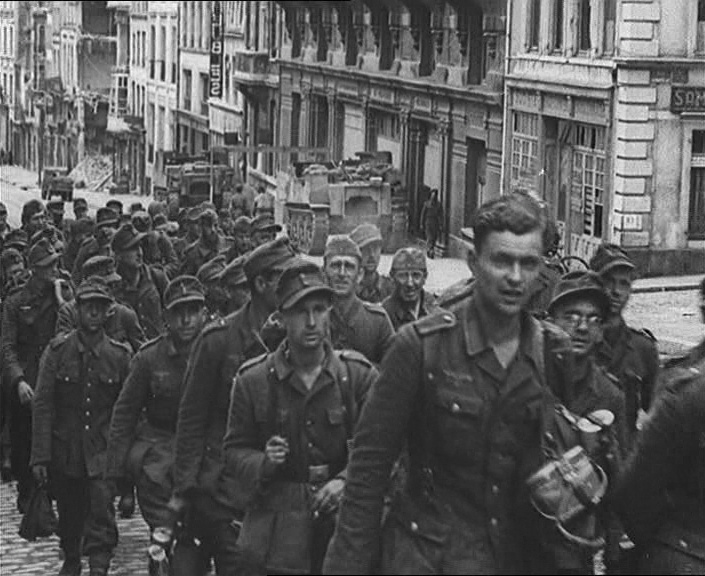
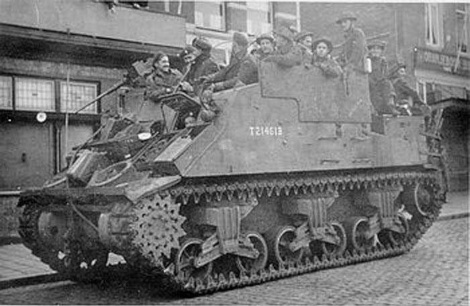
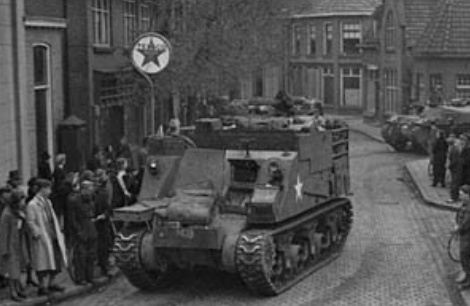
One would think that 30 September 1944 would have marked the end of Commonwealth use of the M7 in any form in Northwest Europe. However, there are a few photos showing M7 Kangaroos in service later on with elements of the 4th Canadian Armoured Division. On 29 August 1944, the Daily Balance Sheet for “E” Squadron, 25th Canadian Armoured Delivery Regiment has it that "Tp Carrier SP" S214613 was issued to "10 Inf Bde." Recall from a document shown two captions earlier that the 10th had turned in 5 M7 Kangaroos on 22 August. Additionally, S230568, S215851, S215892, S215762 and S230602 were issued to "5 Armoured Bde" on the 29th. We think this might have been a typo, and the writer meant "4th Armoured Bde" since the 5th Canadian Armoured Brigade was in Italy at that time. The A & Q Branch, HQ, 4th Cdn Armd Div War Diary states that 5 "Priests" each were used by the 4th Cdn Armd Bde and the 10 Cdn Inf Bde during the final stages of the Falaise Pocket battle. The Kangaroos were used to bring supplies to the beleaguered Poles and to evacuate the wounded. On 21 August, Lt.Col. John Proctor opined that "In fluid fighting of this type Priests are vital to the maintenance of an Armd Bde." Thus, we believe that as they crossed the Seine in late August, the 4th Cdn Armoured Division may have specifically requested a few Priest Kangaroos even though they were not part of the Division's War Establishment. In any case, the photo on the left shows one of the APCs that was issued on 29 August, S214613, as it appeared two months later in Bergen op Zoom, The Netherlands, 29 October 1944. Note that the usual "S" WD Number prefix has been replaced by the "T" for "Tank" prefix for some reason. In this case the additional side panel does not appear to be the splash plate from the wading kit although it does seem to have been cut to the same pattern. On the right, we have a photo by Captain A.M Stirton taken on 4 April 1945, about a month before VE-Day. The caption simply reads, "Entry of the 4th Canadian Armoured Division into Delden." The actual location can be pinpointed in Google Street View as 68 Langestraat in Delden, The Netherlands. This APC appears to have been modified for maximum supply carrying capacity, and there looks to be a similar unit right behind it.
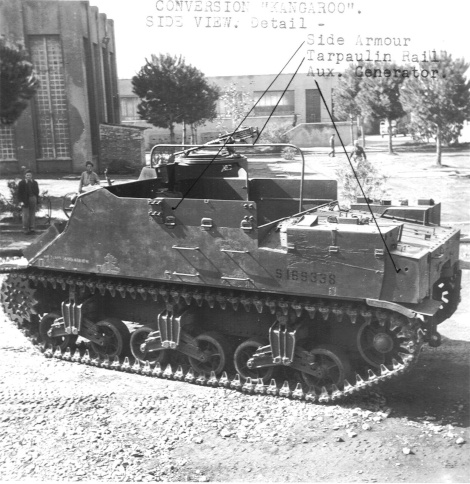
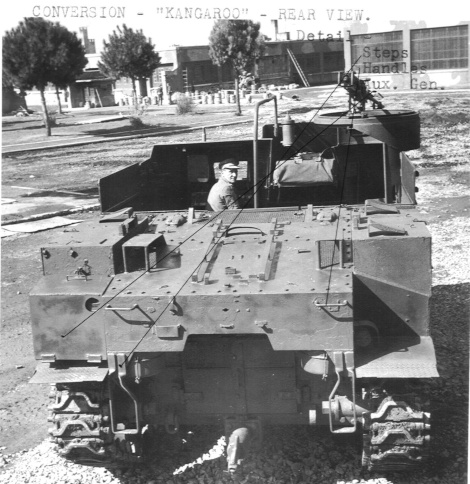
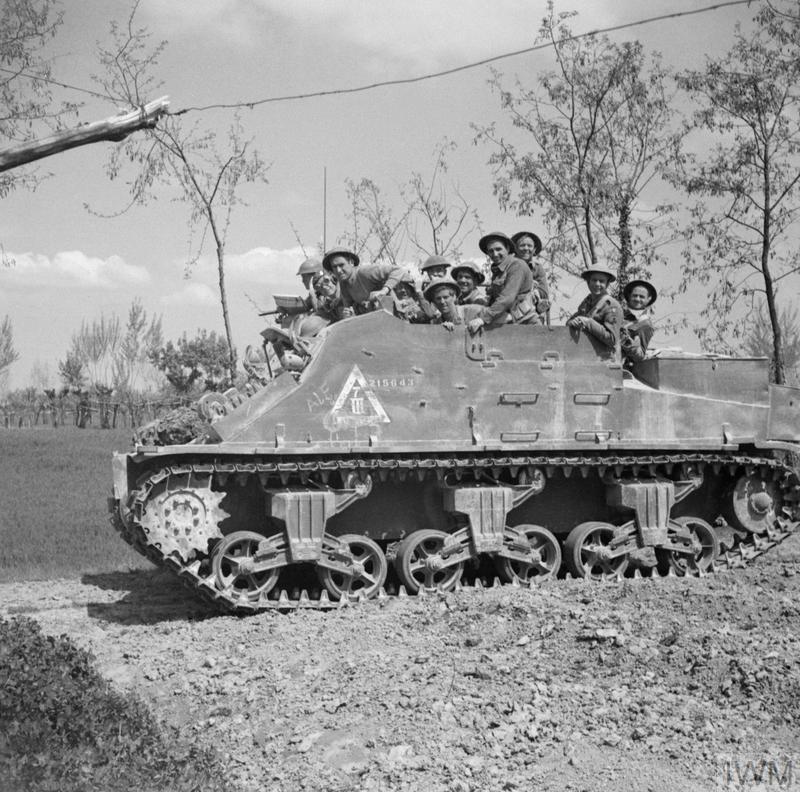
It is thought that the Kangaroos of the 4th Hussars were organized into two squadrons each with approximately 50 units, with C Squadron having Sherman based APCs and A Squadron having M7 based. A War Diary entry leads us to think that there may have been an additional "6 Priests" in the Regimental Headquarters. B Squadron reportedly provided an armoured protection detail consisting of 17 Sherman gun tanks. This Imperial War Museum photo is part of a series dated 13 April 1945. The caption reads "Carrier-borne infantry and tanks plough their way through vineyards and orchards in pursuit of the enemy near the village of Conselice...9th Lancers & 38 (I) Bde, 78th Div." The M7 APC can be seen as "S215643", and the name "ALE" is chalked(?) on the side. The Kangaroos of the 4th Hussars appear to have had tactical markings painted on. The triangle would indicate A Squadron, and we "interpolate" that the Roman numeral "III" inside the triangle denotes "Third Troop", with the "7" indicating that it was the seventh vehicle of the Third Troop. On a number of occasions, the 4th Hussars' War Diary refers to Troops 1 through 4 and no higher leading us to think that the Squadrons may have been composed of 4 Troops, each with about 12 APCs. We count 11 men in the photo, although a description of the conversion states that "it will be found possible to accommodate 15 infantrymen in battle order, with their rifles, in addition to the driver/W.T. operator." The description from Mediterranean Area AFV Technical Report 27 also states that "Collapsible sides fixed to the top of the existing side armour were thought to be necessary but if this arrangement was not readily available, the armour plate should be welded into the same position." We interpret "collapsible sides" to mean the hinged armor plates that could be folded down and were intended to add protection to the M7's partially exposed vertically stored rounds. In the photo, the added plate appears to be one of those provided in the US produced Modification Work Order kit, but the misalignment of the hinges suggests that it is welded into place, so not "collapsible." Based on the caption's date, we believe that the passengers shown here were with the 2nd Battalion, London Irish Rifles of the 38th (Irish) Brigade, 78th Infantry Division. For the final offensive in Italy, they formed part of the "Kangaroo Army" made up of over 100 AFVs, including gun tanks, flails, bridge layers, flamethrowers and bulldozers. "Each company, [of the 2/LIR] together with its allotment of eight Priest ‘Kangaroos’, lived and worked with its own squadron of the 9th Lancers. The ‘Kangaroos’ were stocked with reserve ammunition and forty-eight hours’ rations, thus making the force completely independent for a substantial period, if necessary." As a matter of minutia, we would point out that the visible grouser box on "S215643 can be seen to be in the "mod 1" configuration with the small plates with rounded corners welded on to the box. This setup has been noted on a few Commonwealth Priests in Italy, but presently we have not seen it in any photos of US Army M7s there. IWM NA 24043.
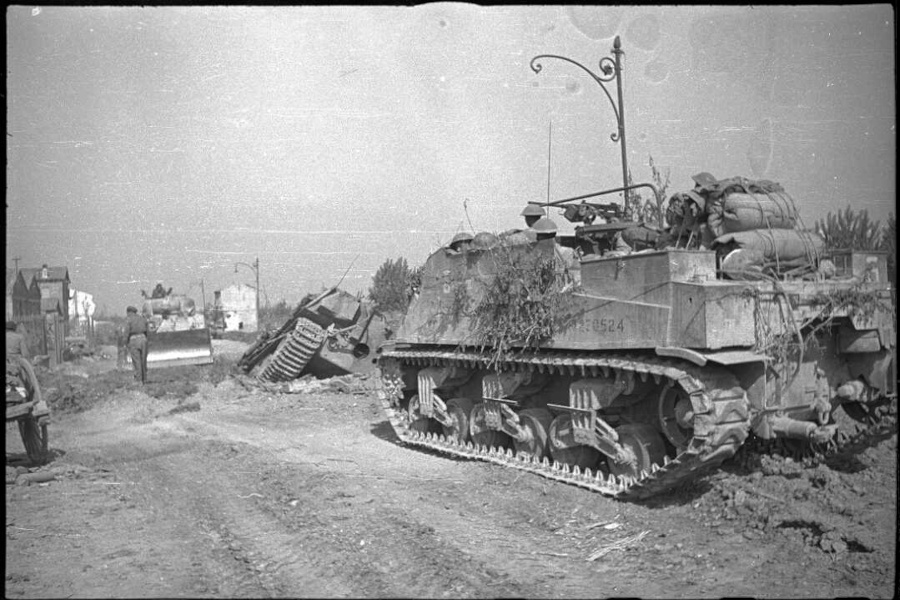
For the final offensive in Italy, A Squadron of the 14th/20th Hussars was converted to M7 Kangaroos at the beginning of April 1945 and was placed under command of the 43rd Gurkha Lorried Infantry Brigade, with its 2nd Battalion, 6th Gurkha Rifles receiving brief training with the APCs. One source has it that A Squadron was equipped with 40 Kangaroos, with the rest of the 14th/20th Hussars remaining armored and consisting of 28 Sherman gun tanks divided among B and C Squadrons and the Regimental HQ. This photo is dated 17 Apr 1945, and the caption reads, "In the town of Medicina, a Sherman dozer prepares the way for two New Zealand tanks [Priest Kangaroo APC] to pass, carrying military personnel." The reference to "New Zealand tanks" [plural] might be explained by the fact that the 43rd Gurkhas were attached to the 2 New Zealand Division at this time. Also, the caption writer might have mistaken what appears to be a knocked-out Panther in front of the Priest APC for another Kangaroo. In any case, the Gurkhas' history notes that "at least one tank (reported as a Mark V Tiger, it was probably an enhanced Mark IV)" was destroyed in the course of the action. The Battle of Medicina (16/17 April 1945) was a close quarter street fight in a small town. "Fighting from building to building, dismounted from their Kangaroos, the Gurkhas fought their way into the town, ably supported by the 14/20 KH tanks which could blow holes in walls with their 75mm guns to allow the infantry to get in." Allied troops reportedly suffered "slight" casualties of 7 men, but perhaps illustrating the intensity of the fighting, those casualties included "a GOR [Gurkha Other Rank] run over by a Kangaroo, and another killed in a Kangaroo that turned over." The photo is thought to have been taken after the battle as the Gurkhas cleared the town and continued their advance to the Po River. The M7 APC can be seen as S230524, which is on a list found by author Roderick De Normann that includes the WD Numbers of 40 M7 based Kangaroos issued to 14/20 Kings Hussars from 276 ADS [Armoured Delivery Squadron], Italy, 1 April 1945. We cite that because the Gurkha history has it that "their Kangaroos were converted Shermans", but as far as we can tell, A Squadron 14th/20th Hussars was only issued M7 Kangaroos. As mentioned earlier, a pair of handles and steps were retrofitted to the rear of the vehicle with the intention that the troops would "bus" and "debus" from the rear. However, in this case, there is quite a bit of gear secured to the engine deck. A pair of L brackets can be seen affixed to the middle and rear bogies which may have been added to provide assistance in bussing/debussing from the sides. The few available photos show that some of the Priest Kangaroos were equipped with extended end connectors to improve floatation as seen here and in the previous image. Photo DA-09220-F courtesy of the Alexander Turnbull Library.
US Army use in ETO
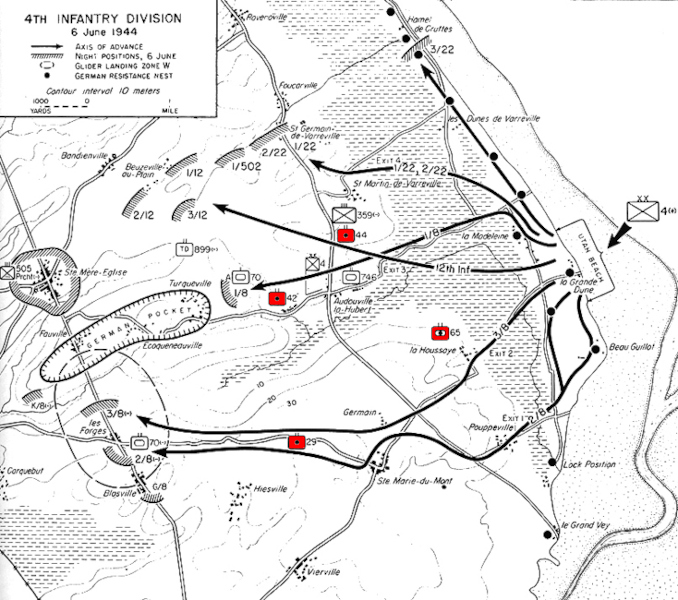
US Army use of M7s in the European Theater was generally limited to armored field artillery battalions. However, for the landings at Utah Beach on D-Day, the 4th Infantry Division's "three light field artillery battalions, the 29th, 42nd and 44th, were issued self-propelled 105mm howitzers, M7, in lieu of the towed howitzer." The field artillery battalions organic to US infantry divisions were organized into three firing batteries, A, B and C each with 4 guns, for a total of 12 per battalion, so it is thought that the 4th ID's field artillery battalions came ashore with 12 M7s each. In addition, the 4th ID's After Action Report states that the veteran 65th Armored Field Artillery Battalion of the 5th Field Artillery Group was attached for the assault at Utah. All of the SP units were to be transported in LCTs and, as with the Commonwealth Priests and Sextons used on D-Day, they were to provide "fire afloat" but appear to have been allotted only 15 rounds per gun for this action. The 4th ID's 8th Infantry Regiment led the first wave of the assault, and the current pushed its landing craft about a mile south of the planned landing zones into an area that was not as well defended. This enabled the troops to touch down more or less intact and in good order. A commentator in the AAR called this "An act of Providence." As a result, the assaulting and follow up waves were able to move inland and make contact with elements of the 82nd and 101st Airborne Divisions. At Utah, a more or less secure beachhead was established before noon, permitting over 21,000 men and 1700 vehicles to be put ashore before the end of the day. The 29th Field Artillery Battalion claims to have been the first artillery unit to land at about 0930 hours. However, Battery B was destroyed about a mile offshore when its LCT [LCT(5)-458] was blown up by a mine killing 39 gunners and injuring 20 more. Despite this devastating loss, the M7s of Batteries A and C provided fire support to the 8th Infantry Regiment as it made its way inland across the few causeways that traversed the inundated area behind the beachhead. The commander of the 29th Field Artillery Bn., Lt. Col. Joel Thomason, described the unit's actions on D-Day, "During the afternoon we moved the battalion to a position south-east of St. Mere Eglise and some seven or eight miles from the beach. There we fired some missions throughout the afternoon and night in support of the three battalions of the 8th Infantry. When darkness came at about 10:30 PM, we set up the harassing and interdiction fires on suspected enemy locations and key road junctions." The 65th AFA Bn with 18 M7s is also stated to have landed at 0930. Its mission was to move inland as quickly as possible and provide support to the 101st Airborne Division. During disembarkation, "One howitzer was put out of action by artillery fire" and another lost a track to a mine. PFC Denver O. Sayre who served with Battery C, 44th FA Bn wrote of his experiences on D-Day. Sayre reported that he landed with the 3rd Battalion, 22nd Infantry [4th ID]. "As F.O. (Forward Observer), it was necessary to move forward with the infantry to obtain a clear view of the enemy emplacements to direct our artillery fire by radio commands...We were glad when we heard that 10:30 AM on D-Day our 105 guns mounted on M-7 tanks came ashore and at 10:38 AM they were firing on the German positions! Our Battery C, 44th F.A. became the first field artillery to fire on targets in France on D-Day." In any case, by last light all of the 4th ID's artillery was in position inland prepared to support further offensive operations or to help repel what the planners anticipated would be the inevitable German counterattack. We could not find a single photo or film clip that we could positively identify as showing an M7 in the Utah Beach area on D-Day. Here we have a map from the US Army Green Book, "Cross Channel Attack" showing the "Night Positions" on D-Day. The artillery units are highlighted in red.
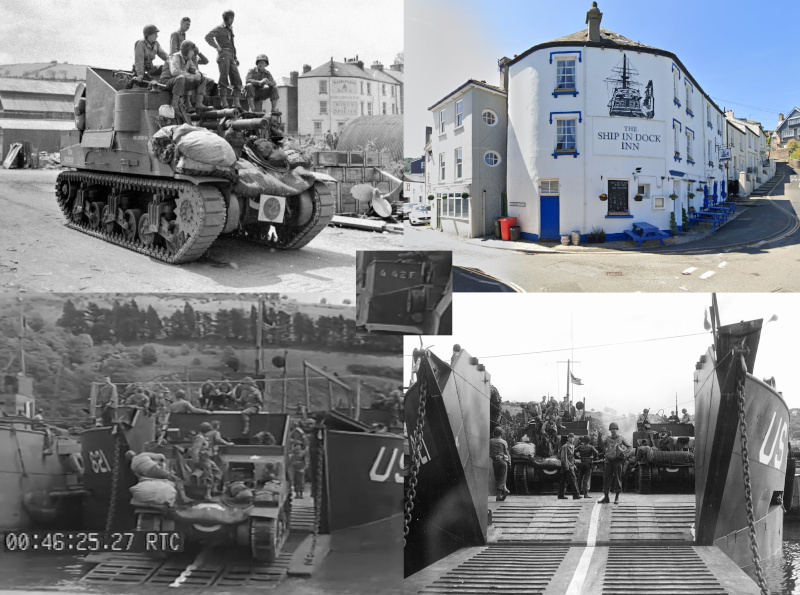
Here we have gone back to southern England a few days before the invasion to show photos of M7s of one of the 4th ID's Field Artillery Battalions. For many years there has been some confusion regarding the unit and the location of the photo of “Big Chief III” (4039530), seen at the top left of our montage. The US National Archives has some film footage showing M7s of B Battery of the 4th ID’s 42nd FA Bn (center inset) loading aboard LCTs on the River Dart at Dartmouth, Devon on or about 1st June 1944. We recognized one of the M7s in the footage as “Big Chief III”, as seen loading aboard LCT-621 in the still at the bottom left. This confirmed the Priest's unit, and we were also able to match “Big Chief III” to a known Signal Corps still photo of LCT-621 (on the left of the photo at bottom right). A close examination of the building in the right-hand background of our original photo reveals that it was “The Ship In Dock Inn”. A bit of searching showed that the very same pub is still open for business, and is located on Ridge Hill, just 50 yards from the River Dart in Dartmouth. In fact, the Inn has a framed copy of the “Big Chief III” photo on its walls. Further confirmation came from the website LCT Stories, which states the “42nd Field Artillery Battalion (force of 342 with 91 vehicles) transported to Utah Beach aboard LCT(6): 765, 620, 621, 662, 763, and British LCT 2421.” To follow up a little on the story of 4th ID's FA Bns, in an "Immediate Report of Combat Observations" dated 15 April 1945, Brig. Gen. H.W. Blakely, Commanding General of the 4th ID wrote," Our divisional light artillery consists of two self-propelled battalions and one towed battalion...Originally all three battalions were self-propelled but one was converted to towed after about three months. I believe the self-propelled is preferrable in this theater. All the chiefs of section want the self-propelled... We could readily use six-gun batteries, thus adding 50% to our firepower." So, it would seem, at least two of the 4th ID's FA Bns remained equipped with M7s up to at least mid-April 1945, and the CG and gunners of the 4th ID thought it would be advantageous if their organic Field Artillery Bns were converted to the equivalent of 18-gun Armored Field Artillery Bns.
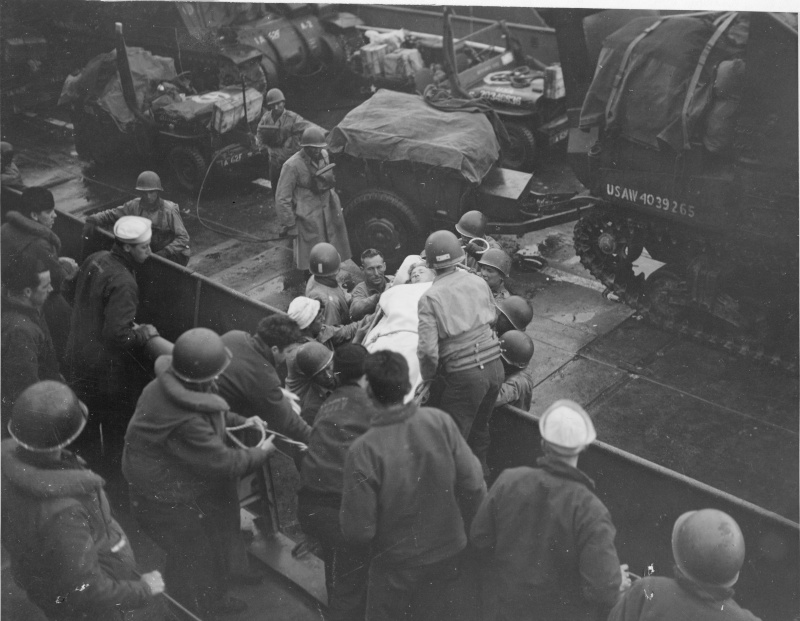
Of the 5 beaches assaulted by the Allies on D-Day, the defenses at Omaha came closest to what Hitler envisioned for his impenetrable "Atlantic Wall." The first assault waves landed at 0630 hours, and suffered such heavy casualties that, for several hours, the stunned survivors were incapable of organizing and mounting any kind of attack. The planners had assumed that the beach defenses would be cleared quickly and had the artillery scheduled to land at H+90 (8:00 am). The two other Armored Field Artillery Battalions of the 5th Field Artillery Group, the 58th and 62nd, were assigned to Omaha in support of the 116th Infantry Regiment, 29th Infantry Division and the 16th Infantry Regiment, 1st Infantry Division respectively. Two Field Artillery Battalions, the 7th of the 16th IR and the 111th of the 116th IR were also assigned, but unlike at Utah, they were not converted to M7s for the assault. Instead, each of their 12 towed howitzers were to be transported to the beach by DUKW amphibious trucks launched from LSTs 7 to 12 miles offshore. This was a disastrous decision, similar to the decision to launch the DD Shermans of the 741st Tank Battalion. As it was, all but 6 of the DUKWs were swamped in the Force 4 sea conditions that existed on D-Day. In the meantime, the After Action Report of the 62nd AFA Bn states that the unit fired a total of 349 rounds from offshore as part of an obviously unsuccessful "beach drenching" program which also involved air and naval forces. The AAR reports that their LCTs tried to land on schedule at H+90, "but were forced away" by intense enemy fire. An oral account by Sgt. Jerry W. Eades of Battery B, 62nd AFA Bn mentions that his LCT was hit by 20mm fire causing a number of casualties. Three M7s of Battery B were finally landed 7 hours later at 1500 hours (3:00 pm), but one struck a mine "and had to be abandoned when the tide came in." The infantry assault had turned the tide of battle at this point, but the beach was still far from safe, and the gunners of Battery B suffered 13 casualties from enemy artillery fire. At 3:15 a second LCT was only able to unload two M7s before it was driven off by "heavy enemy shelling." The two Battery A M7s were placed alongside the two from Battery B landed earlier, "giving our infantry some artillery support from a composite battery of four M7s." The great problem at Omaha was that exits off the beach could not be cleared until late in the day, and all manner of vehicles both working and wrecked were piled up on the shore. At around 4:00 pm, the composite battery was able to move 200 yards inland opposite St Laurent-sur-Mer. At 6:30 pm, two more M7s were landed, but another of Battery B, which seems to have been Sgt. Eades' M7, was "lost off shore" when it drowned in the surf. Just after dark, there was "a low level bombing attack on the beach", but the composite battery of now 6 M7s suffered no damage, and shortly thereafter moved to a new position 500 yards northeast of St Laurent-sur-Mer. Finally, two LCTs carrying 6 M7s of Battery C and 2 of Battery A were reported to have beached at 2200 hours (10:00 pm) about 2 miles east of the composite battery and set up a "firing position 1,000 yards northeast of Colleville-sur-Mer, 500 yards off the beaches." Navy Medicine has posted this fine photo with the caption, "Normandy invasion casualty transferred to LST [sic] for trip back to England...circa June 1944." The tactical marking "1A 62F" can be seen on the Jeep as well as on the M7 in the background, which also appears to have "A-2" painted on. We take this to mean "1st Army, 62nd Armored Field Artillery Battalion" and for the Priest, the number 2 vehicle of Battery A. The Registration Number of the M7 with the M10 trailer is USA 4039265 indicating February 1943 acceptance. Although the caption is dated only "circa June 1944", we can't help but think that the photo was taken on the evening of D-Day before these M7s and Jeeps were put ashore.
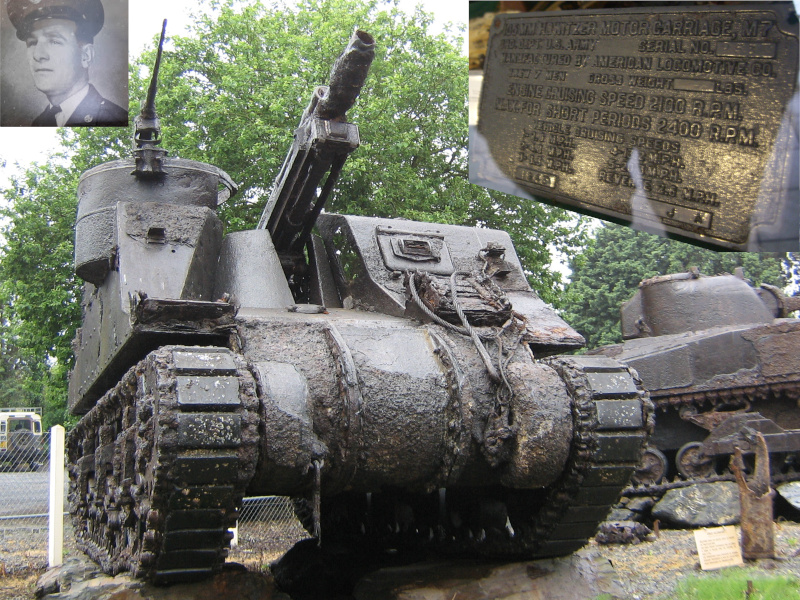
The Armored Field Artillery Battalions of the 5th Field Artillery Group were veterans of the campaigns in Tunisia and Sicily, and, as such, were chosen to partake in the initial assault waves on D-Day. Readers might recall that Batteries A and B of the 58th AFA Bn had supported two "end run" amphibious landings towards the end of the campaign in Sicily in August 1943. The D-Day experiences of the 58th AFA Bn at Omaha pretty much mirrored those of the 62nd AFA Bn. The battalion's M7s "fired afloat" and then the LCTs attempted to land as scheduled at mid-morning but were "prevented from doing so by underwater obstacles and heavy fire." By a process of elimination, we think that M7 SN 2537 shown above on display at the museum in Port en Bessin must have been on LCT 197. According to the "Report of Loss of Landing Craft US LCT(5) 197, LCT(5)294, by Commander, LCT Flotilla 18", dated 10 July 1944, LCT 197 struck a mine which split her seams. For several hours the crew, with the assistance of a repair tug, tried to keep her afloat, and "The craft attempted three more beachings with one engine but was unsuccessful...The craft headed seaward to transfer its load to an LST. At 2035 [10:35 pm] all engines were out, the afterdeck on the port side was inundated. All Army personnel had been previously removed, and at 2055 the ship was abandoned with its complete load aboard. The craft turned over to port almost immediately and sank slowly, approximately four miles off Omaha Beach." The late Jacques Lemonchois claims to have salvaged the Priest 3 nautical miles offshore. The M7's dataplate is on display inside a case at the museum. It is in near perfect condition, so we must conclude that it is a casting made of brass, even though towards the end of 1942, the Army had directed that the plates be made of steel in order to conserve brass. Even more amazing, M. Lemonchois recovered some of the personal effects of Corporal John H. Glass of Battery C, the driver of the M7. These included an envelope with his name, Army Serial Number and unit. Using that information, Lemonchois was able to track down Mr. Glass who returned to Normandy in 1984 at age 65 for what was described as an "emotional ceremony" in which he collected up his lost items including "boots, shaving soap, personal mail and packs of cigarettes." Returning to D-Day, the souvenir history of the 58th AFA Bn reports that "By 1800 hours [6:00 pm], the battalion had 11 of its guns on shore and ready to fire." The 115th Infantry Regiment of the 29th ID requested the support of "a couple" of the M7s of Battery B in its attack on St. Laurent. An officer's report in Joseph Balkoski's fine book, "Omaha Beach" has it that at around 9:00 pm, the M7s "fired direct shots at the enemy-occupied houses from a couple of hundred yards away. The Germans began flying out of the windows right and left. We ended up capturing the buildings due to this devastating direct fire." The 58th reported D-Day losses of 9 men killed, 17 wounded and 10 missing. In addition, the unit had lost 5 M7s with trailers, 5 half-tracks, and 2 L-4 [Piper Cub] observation planes.
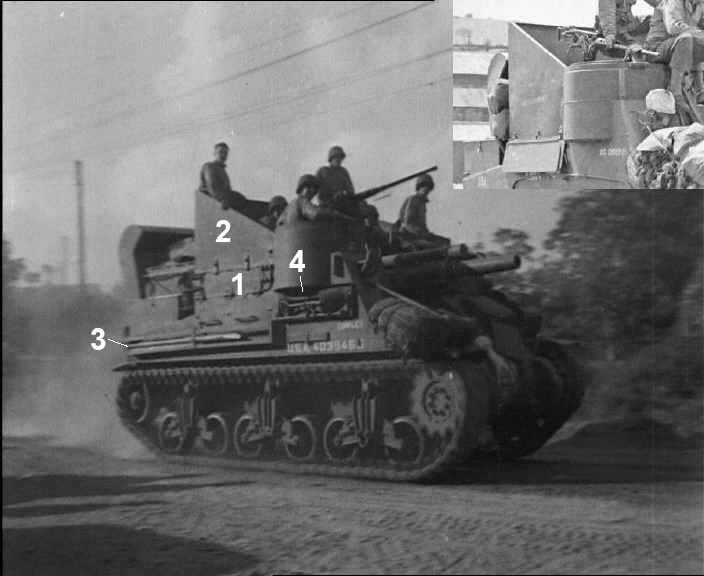

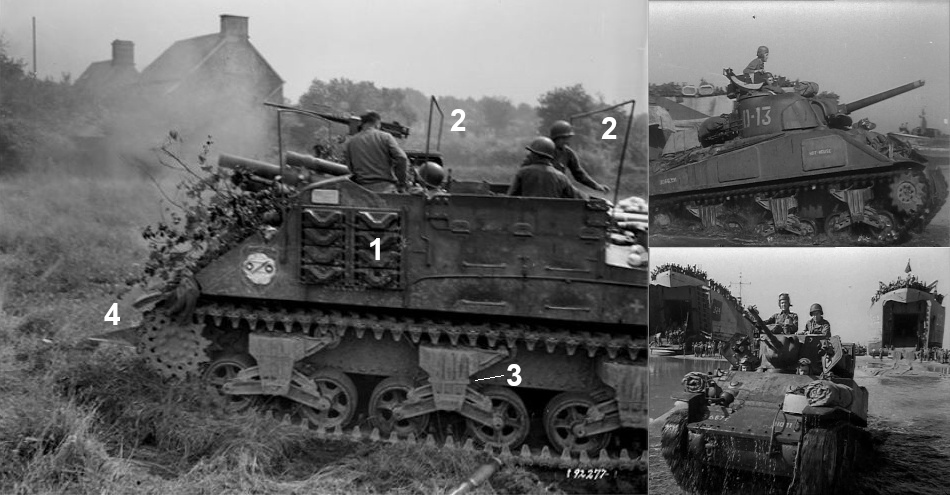
Elements of the untried 3rd Armored Division began landing at Omaha Beach on 24 June 1944. The 2nd and 3rd ADs were the only US armored divisions in the ETO that retained the "heavy" table of organization and equipment (T/O&E). In a nutshell, the heavy T/O&E authorized 232 Medium tanks versus 168 authorized to the "light" armored divisions, the 4th through 14th, plus the 16th and 20th. Both the heavy and light armored divisions were authorized 3 Armored Field Artillery Battalions, each with a total of 18 M7s. The AAR of the 67th AFA Bn notes that the unit supported Task Force Y during the 3rd AD's first major engagement, an assault on Villiers Fossard starting on 29 June. There is some evidence that the 67th was equipped with at least two tanks in the Headquarters and Headquarters Battery for use by the unit's forward observers. Lt. Irving Rudnick, one of the Battalion FOs stated, "Lt. O'Brien and Lt. Langsdorf joined me at 2230 hours in a medium tank. Lt. O'Brien stayed with me and Lt. Langsdorf took my light tank back to the Battalion CP." These tanks may have been filmed landing from an LST on 24 June as shown in the small screen captures on the right. Eventually, the HQ & HQ Battery of an AFA BN was authorized "3 medium tanks", but it would seem that this authorization was still in transition in mid 1944. We couldn't find a photo of a 3rd AD M7 in action in June or July, so instead, the main photo shows an M7 identified in the caption as "Btry C, 39th Armd. F.A. Bn., 3rd Armd. Div... [blasting] away with another round at German positions near St. Pois, France. 3 Aug. 44." The caption writer appears to have misidentified the unit. It seems likely he meant 391st, one of the 3rd AD's organic AFA Bns. Judging by the M3 type drive sprocket, this is likely a 1942 production M7 that had been modified by the addition of the "folding armor plates" which seems to have been the case with almost all of the US Army Priests in Normandy. A pair of track holders (1) can be seen to have been retrofitted to the side of the vehicle, and the crew appears to have improvised their own fittings (2) and mounting points for a camouflage net. Note the little American flag (inset) above the track holder. A close examination of the print reveals what we think is the name "Chicago" half hidden at the bottom of the track holders. The middle and rear M4 type bogies have been retrofitted with bars (3), no doubt to offer additional climbing footholds for the crew. The item poking out from the differential housing is part of a hedgerow cutter device (4). These were added to US tanks and other AFVs prior to the start of Operation Cobra on 25 July 1944. Cobra proved to be the decisive blow that ended the stalemate in Normandy and broke the front wide open. The AAR of the 391st records that on 4 August, "friendly 57mm fire penetrated the left side of the FO 2 tank turrent [sic]", wounding Sgt. Theodore D. Root of Hq Battery. So, we have a little more evidence that the AFA Bns were equipped with a few tanks.
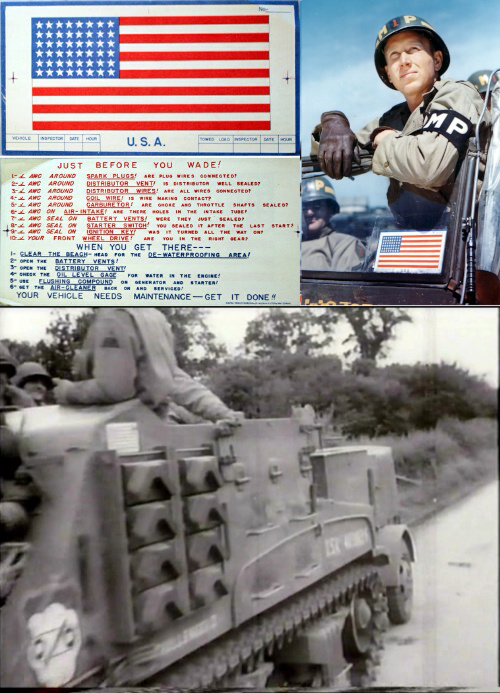
As matter of minutia, we thought we might comment on the little US flag. It appears that it was one of the double-sided stickers that had wading and de-waterproofing instructions on the back (upper left). It was designed to be stuck to the windshields of tactical vehicles (upper right) with the flag, of course, facing outwards. The lower image is a screen capture showing the same flag (and track holders) on "Challenger II" of the 391st AFA Bn, so perhaps some of the crews stuck it on their M7s as just a flag.
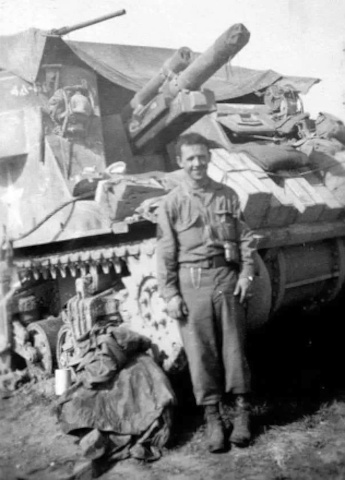
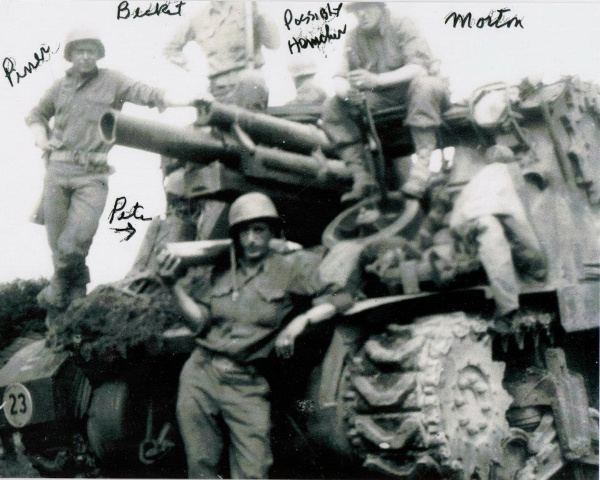
The 4th Armored Division began landing at Utah Beach in mid-July 1944 and played a prominent role in the Operation Cobra breakout. The division's organic Armored Field Artillery Battalions were the 22nd, 66th and 94th. In "Patton's Vanguard", author Don M. Fox states that "On July 29, the Fourth slashed its way south from Coutances in relentless fashion. The drive was so fast and furious that the two artillery battalions assigned to CCB, the 94th and 66th, had to play leapfrog in order to provide artillery support and keep the vanguard within range. One Battalion would fulfill fire missions while the other moved south; then the battalion that had moved closer to the fighting would stop and take over fire missions, while the trailing battalion pulled up stakes and drove to a position still closer to the front". After the breakout at Avranches, the 4th AD encircled Rennes and cut off the Brittany Peninsula, reaching Vannes and the Lorient area on 7 August. On 13 August, the division started its race east through Orléans and Troyes, then crossed the Moselle River, encircled Nancy and captured Lunéville on 16 September. At that point, the 5th German Panzerarmee was ordered to retake Lunéville, but the inexperienced 111th and 113th Panzer Brigades were virtually destroyed by the 4th AD during the much-studied Battle of Arracourt 18-29 September 1944. Although it is not mentioned in the 66th AFA Bn After Action Report, several sources describe an incident that happened on 19 September at the Headquarters of Combat Command A. "The HQ [at Arracourt] was under attack by more Panthers. The M7s of the 66th AFAB were using direct fire in an attempt to hold them at bay. Firing from a distance of only 650 yards, they held off the tanks until B/37 [B Co/37th Tank Battalion] arrived at 1100 hours...CCA’s headquarters was saved." The snapshots above were kindly provided by the son of T-5 George Hemcher. In the photo on the left, George is shown towards the end of the war posing in front of his M7, "Bonjour" of Battery B, 66th AFA Bn. The photo on the right was taken in Les Clérimois near Troyes, France in August 1944, and shows George's friend and longtime section commander, Sgt. Peter Belpulsi, holding a 105mm round. Of interest is that Peter's brother, Ernest, was the commander [Chief of Section] of another M7 in Battery B. George Hemcher Jr states that his father "was originally the Armorer. As the crew changed, he also changed duties. He wrote a letter saying that he also served with the 51st and 53rd AIB's. As well as 35th and 37th TB. A seven-man crew wasn't always necessary. So, he volunteered as other units needed replacements. But the original #1 man was wounded and never returned. Henry Haug replaced him. At some point in 1945 my father replaced Haug as #1 then became the M-7 commander after Haug was gone. Haug and Belpulsi were friends of mine and verified this. They all said that after three years of training we were trained to handle any position on the M-7."
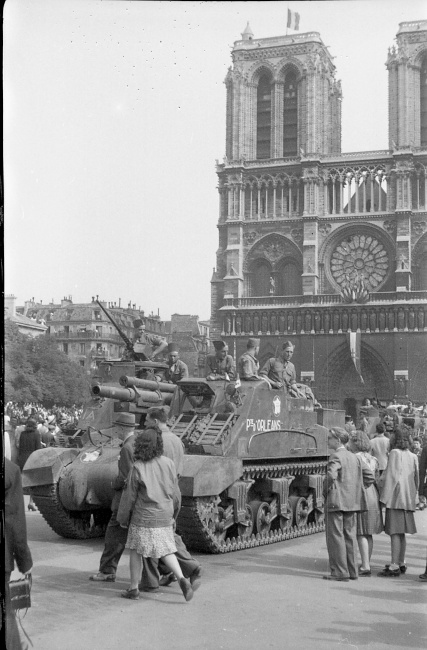
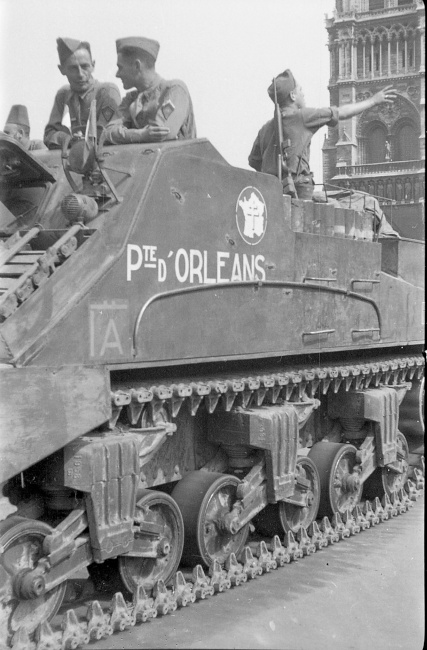
US Lend Lease documents have it that the French received a significant number of M7 Priests - 283. Most or all of them appear to have been deployed with their three armored divisions. For instance, the French 2nd Armored Division or 2ème Division Blindée, which landed at Utah Beach at the beginning of August as part of the US Third Army, had three artillery "groups" that were similar in structure to the US Armored Field Artillery Battalion. The 1er Groupe, 40ème Régiment d'Artillerie Nord Africain was part of the Groupement Tactique Langlade. The 11ème Groupe Blindé, 64ème Régiment d'Artillerie de Division Blindée belonged to the Groupement Tactique Warabiot and the 1er Groupe, 3ème Régiment d'Artillerie Coloniale was part of the Groupement Tactique Dio. Each artillery group was composed of 3 batteries, each one having 2 sections of 3 guns, for a total of 18 M7s. The "Journals de Marche et Opérations" (French equivalent of "After Action Reports") of these artillery groups mention that most of the M7s were issued to the units while in Morocco between mid-January and early February 1944. Despite that, many of the 2ème DB M7s seen in period photos are ALCO 1942 production, that is, they are noted with shallow pulpits and/or M3 type drive sprockets. Also, none of the 2ème DB M7s appear to have been retrofitted with the modification which provided for armor protection for the exposed 105mm rounds. This mod seems to have been mandated for US M7s in the UK before D-Day. Perhaps there weren't enough kits to provide for the 2ème DB? The photo shows a scene from the "finest hour" of the 2ème Division Blindée - the Liberation of Paris. The division's M7s are well represented in the photos and film footage taken on that historic day, 26 August 1944. "Porte d'Orléans" of the 32ème Batterie, 11/64e RADB stands in front of one of the iconic symbols of Paris, Notre Dame Cathedral. The crew has removed all but the front sections, but this Priest appears to have been shipped with the type of sand shields that were original equipment on most Grants.
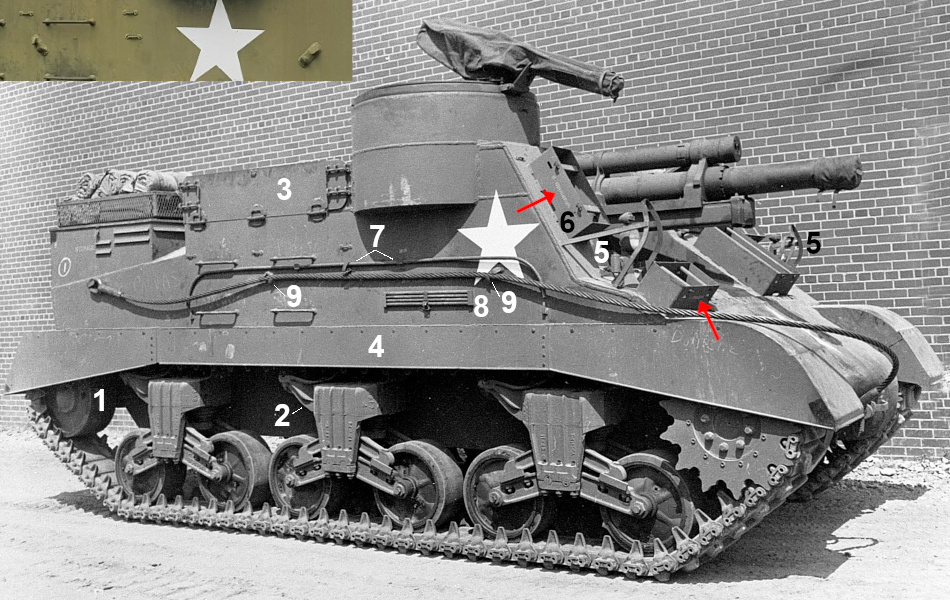
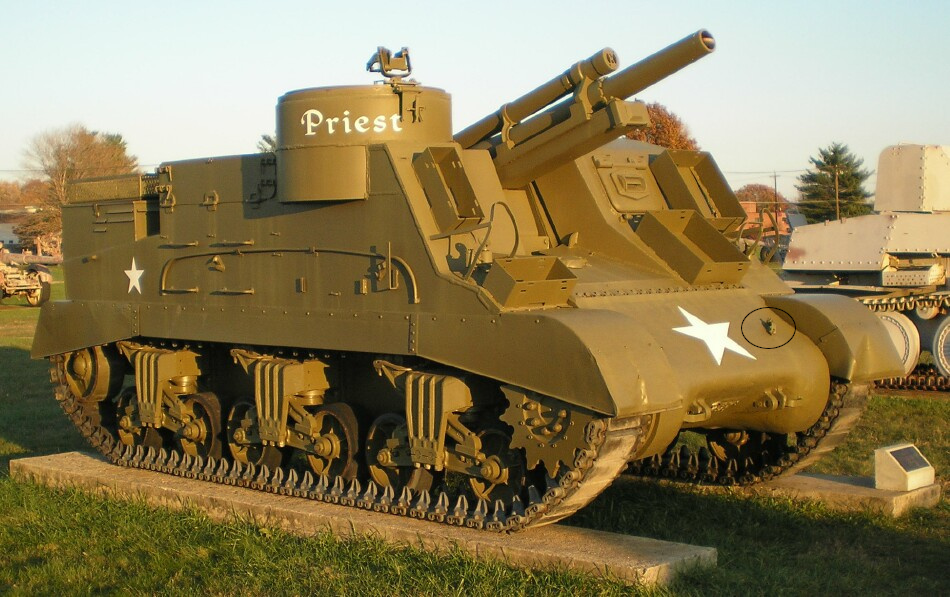
Serial Number 3167 would have been accepted in August 1944. It was on display at the Ordnance Museum at APG for many years and strikes us as the surviving example of a 1944 ALCO M7 that is closest to "as built." For instance, it would appear that the sand shields were never removed. On the other hand, we suspect that its original tracks and road wheels may have been switched out at some point during the course of its service. The Serial or Registration Number of the M7 shown in the previous caption is not known, but we would guess that it might have been made a little earlier than SN 3167 since it lacks the cable clamp (circled) on the differential housing which became a standard fitting on 1944/45 Priests. Without the retaining bars, the configuration of the pairs of holes on the grouser boxes is easy to see. These would have made the retaining bars height adjustable, with the inboard upper holes presumably included to accommodate items other than grousers, such as spare tracks. We only know of 9 surviving 1944 ALCO M7s, and all of them have grouser boxes with two pairs of holes. Frankly we are somewhat surprised at the consistency of that. One would think that some of those boxes would have rusted out over the years and been replaced by something homemade and not necessarily an exact copy. An examination of 1944 M7s in period photos also consistently shows the "two pairs of holes" grouser boxes. Based on counting heads, we would conclude that these were exclusive to 1944 production ALCO M7s; that is, we don't see any evidence that they were factory installed on M7B1s or Federal Machine and Welder M7s, and hence we believe that these grousers boxes with two pairs of holes are an ID feature that can be used to differentiate between 1944 Production M7s & M7B1s from the front.
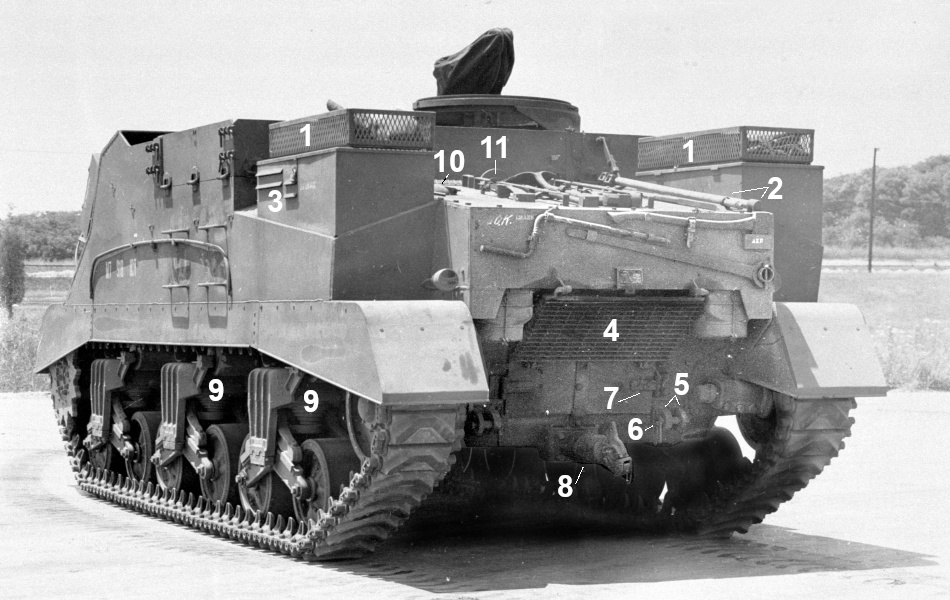
Here we have a rear view of USA 4039918, a June 1944 M7 that was the subject of an Inspection Control Test at APG. "Blanket baskets" (1) were mounted on top of the stowage bins, forcing the rearrangement of the tool stowage yet again with the engine crank and track wrench moved to the upper rear hull plate. The bore brush staffs (2) were relocated from the interior firewall to the engine deck, although the 1944 Tech Manual does not seem to have been updated to reflect this change but gives the former location. The "fuel tank compartment ventilating grilles" and "grille protecting covers" are no longer present on the engine deck. Ventilation was handled by the addition of some louvers (3) on the fronts and outer sides of the rear stowage bins which permitted air to enter the engine compartment through pipes inside the bins. The 1944 production M7s were equipped with the Barber-Colman type exhaust deflectors (4) which had been mandated to be installed in M4/M4A1 Sherman production in late 1943/early 1944. Note that the upper rear hull plate of the new model was no longer "notched" but went straight across. While earlier production M7s had only one rear towing lug per side, the later model had two lugs per side (5) in order to work with the "Quick Release" towing shackle with handle (6). "Legacy" items that carried over from earlier M7 production were the M3 type of hinges (7), which have a sideways "T" shape. The use of the long trailer towing pintle (8) also appears to have carried over to ALCO's entire 1944 M7 production. This example "still" has the straight return roller arms (9), but we would guess that supplies of these were nearing exhaustion by June 1944 and were in the process of being replaced by the upturned type as seen in the previous photo. For future reference, take note of items 10 and 11 in the photo.
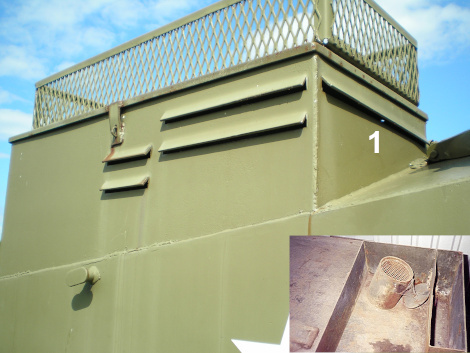
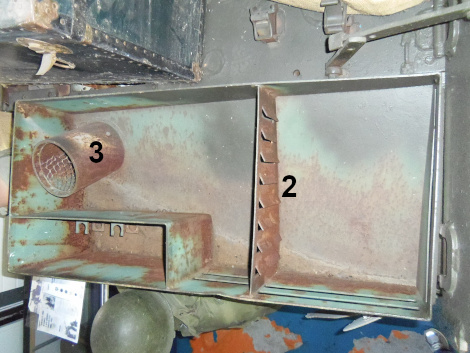
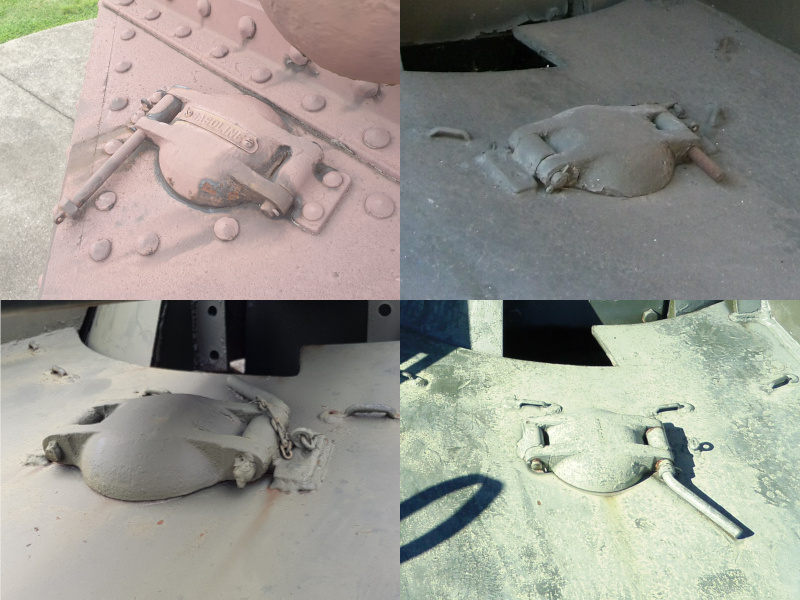
The photo in the upper left shows the configuration of the M3 Medium type armored fuel filler cover with the "short and straight" locking pin. These featured middle hinge sections with "tabs" that were attached to the hull by a pair of rivets. This was photographed on a diesel engine M3A5 Lee, perhaps the only surviving example that still has one of the "short and straight" pins installed. Note the "GASOLINE" label screwed on to the cover. As best we can tell such labels were not factory installed on any ALCO M7s. On 1942/43 M7s, the covers used the "short and straight" locking pins, but the tabs were welded to the hull as seen in the upper right on SN 179 a July 1942 M7 on display in Italy. The lower left photo shows a July 1944 model M7, SN 3099 that has retained the welded-on tabs, but has replaced the "short and straight" locking pin with an "angled" locking pin. There are not many such surviving Priests, but we believe that this was the typical configuration of 1944 production M7s. The photo on the bottom right shows an M7B1, SN unknown, on display in Helena, Montana. In this case, the middle hinge barrel has no tab, but is welded directly to the hull, plus there is the "angled" locking pin. This is the configuration seen on the vast majority of Shermans. We believe that it was also the configuration used on M7B1s along with the Federal Machine and Welder M7s, all of which were produced in 1945.
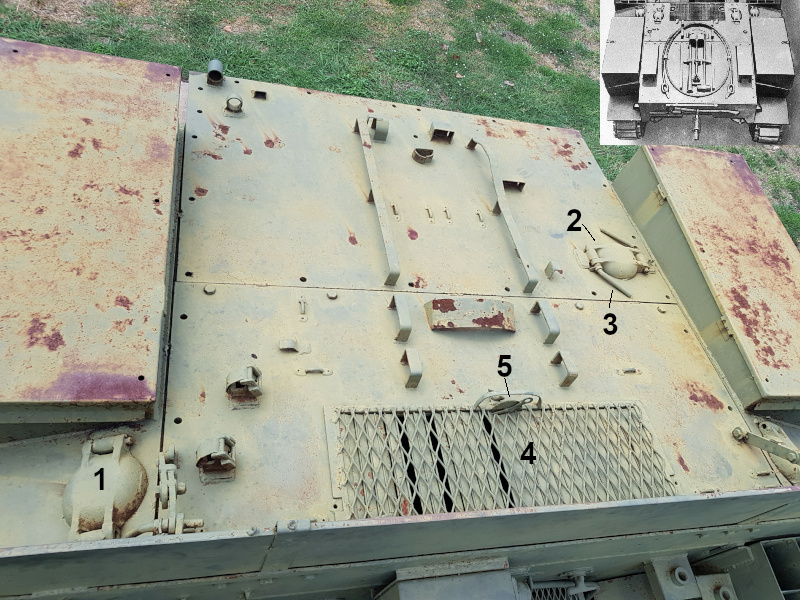
The photo shows the engine deck configuration typical of a 1944 production M7. This is SN 3099 (July 1944) on display at the 1st Cavalry Division Museum at Fort Cavazos (formerly Ft. Hood) Texas. M7s were built with four main fuel tanks, and on the 1942/43 models, each had its own filler point. M7s produced in 1944 and 1945 were similar to Second Generation M4 and M4A1 Shermans in that they were plumbed in such a way that only a single filler point (1) was required for the two fuel tanks located on either side of the hull. Thus, the filler points located on each side of the air intake on the earlier models were eliminated. Also similar to Second Gen radial Shermans, the 1944 M7 added a new armored filler cover (2) to the rear engine deck plate. This was for the "engine oil tank" and included a "bayonet gage located under fill cap." When this was added to Shermans, a small, pressed metal tag reading "LUBRICATING OIL" was placed next to filler cover. We can't say we have seen that on the few surviving examples. As built, there would have been only one angled locking pin (3) not two as on this example. While M7s did not suffer high casualties in combat, they were subjected to counter battery fire, and one might have expected that the 1944 M7s would have introduced an armored cover over the air intake such as was standard from the start on M4 and M4A1 Shermans. That was not the case. As seen here the intake remained unprotected except for a wire mesh screen. However, per the Tech Manual, under the screen there was an "air inlet shutter (4) installed in the engine compartment front top plate [that] controls the amount of air drawn into the engine compartment. The air inlet shutter control (5) may be placed in "OPEN," "CLOSED," or three intermediate positions." For a little reminder, the inset shows the typical engine deck configuration of most 1942/43 production M7s.
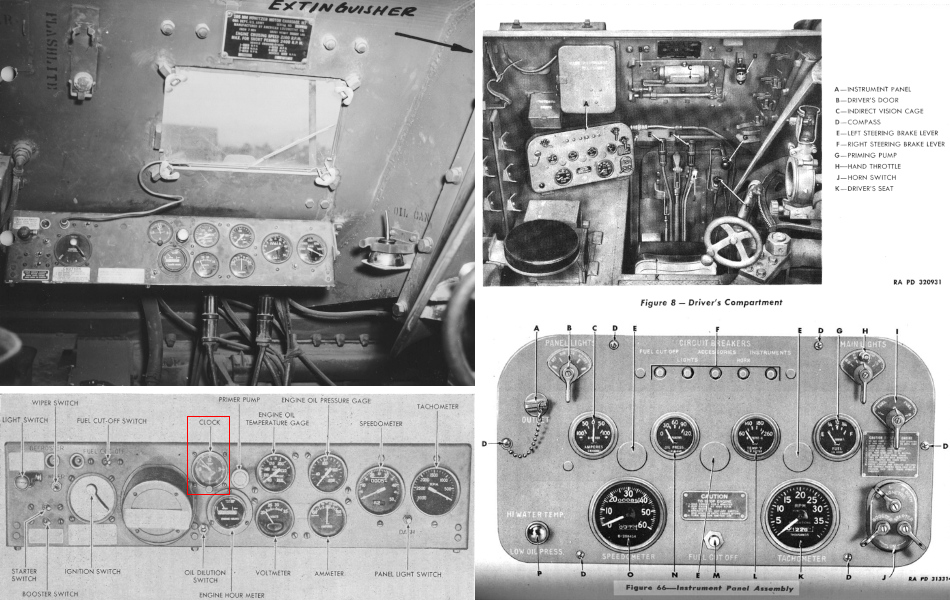
The M7 Technical Manual notes that the "Early Models" had "Instrument panel mounted on front hull wall" as shown on the left. This was the same panel as used on the M3 Medium and is sometimes referred to as the "tractor" type. The "Late Models" had "Instrument panel mounted on left front sponson" as seen in the upper right. The TM specifically mentions that the clock on the instrument panel (highlighted in red) of early or 1942/43 M7s was removed from the late models (1944/45), probably because dashboard clocks were notoriously unreliable at the time. The Tech Manual images running across the bottom show the various gauges, switches and buttons of the "tractor" and later "tombstone" type instrument panels.
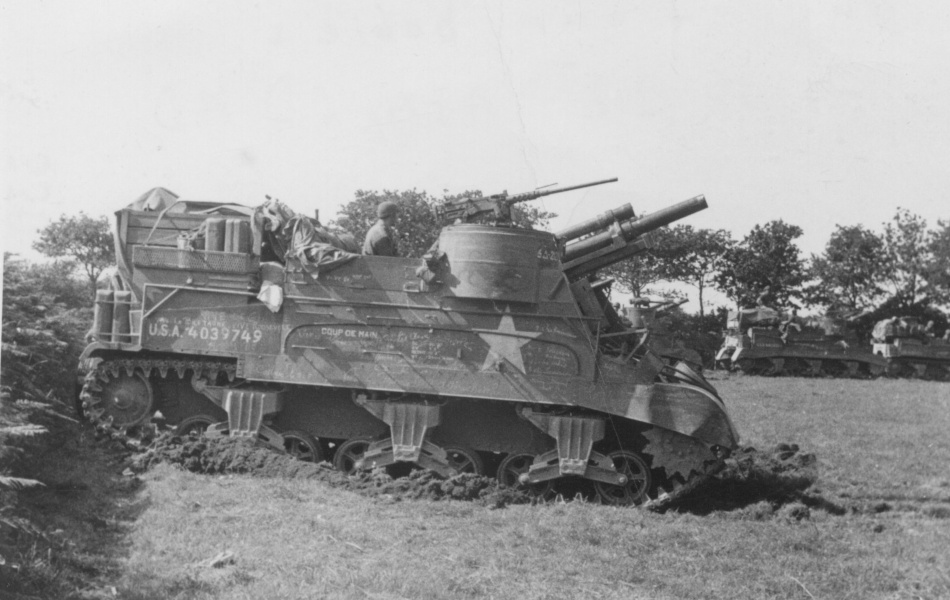
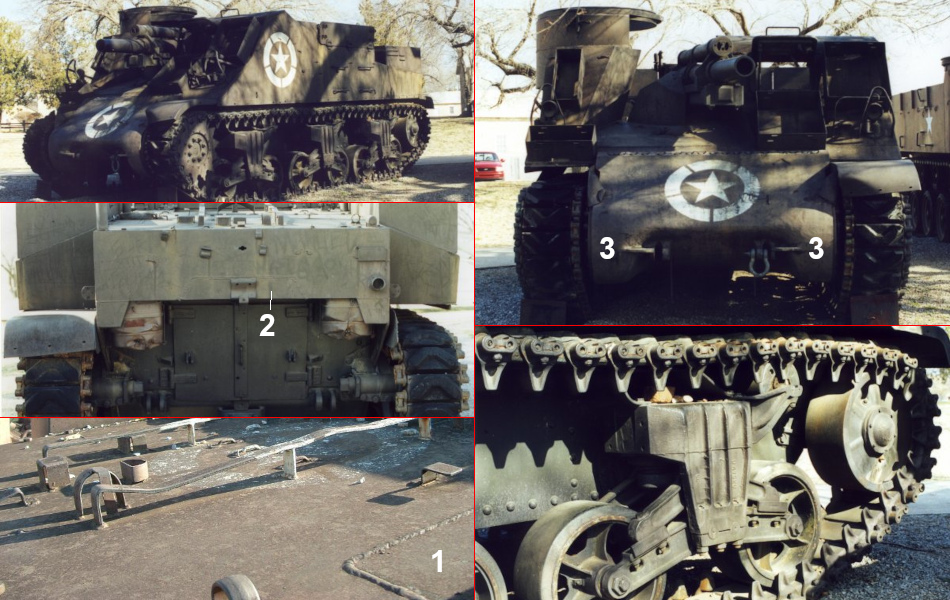
Speaking of riveted lower hulls, here we have photos of the only known (to us) surviving example of a 1944 ALCO M7 with a riveted lower hull. This is SN 2843 indicating that it was accepted in March 1944. It would have been assigned USA 4039759, so built 10 units after 4039749, "COUP DE MAIN" shown in the previous caption. We might assume that the Ordnance Inspector at ALCO let a few excess riveted lower hulls pass at first. The upper hull also appears to have been built originally in the 1942/43 configuration and "recycled" for the 1944 model by filling in the various holes (1) on the engine deck. A close inspection also shows that the upper rear hull plate notch (2) has had a piece welded in to conform with the current design. We wouldn't be surprised if the early type E8543 differential housing with the cast in steps (3) was original to SN 2843. These photos were taken at Ft. Sill, Oklahoma over 20 years ago when SN 2843 was displayed outside. Courtesy of Keith Ross.
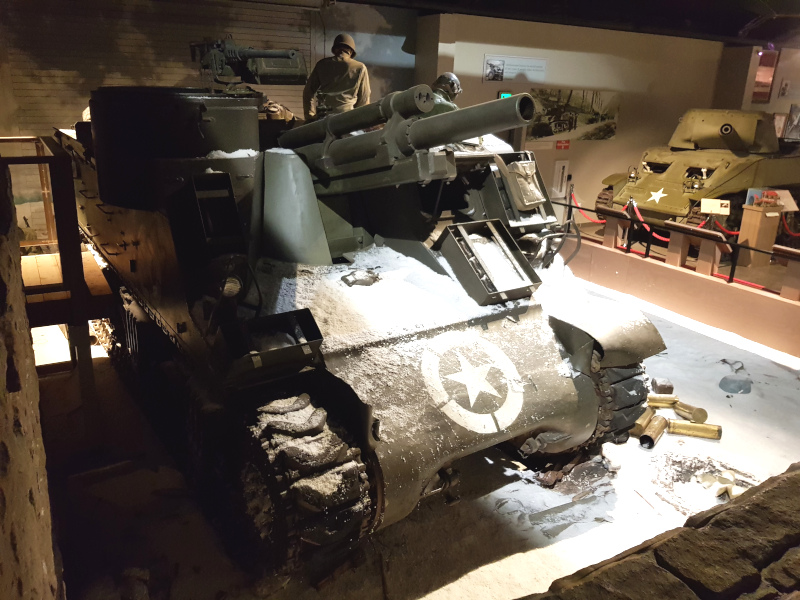
The U.S. Army Field Artillery Museum opened in June 2009 at Ft. Sill, and SN 2843 is now displayed inside in a diorama depicting an M7 of the 420th AFA BN, 10th AD during the siege of Bastogne. The name of the 101st Airborne Division will be forever associated with Bastogne, but Combat Command B of the 10th AD played a key role in the city's defense, particularly in the hours before the 101st arrived. As the city became completely surrounded, part of the western perimeter was manned by a motley group of infantry stragglers, tanks, tank destroyers and the M7s of the 420th AFA Bn. "Team Browne" named for the commander of the 420th, Lt. Col. Barry Browne, repelled a number of attacks in the area of Senonchamps, and protected the artillery assets within the perimeter. Col. Browne died of a shrapnel wound on Christmas day and was posthumously awarded the Distinguished Service Cross. The siege of Bastogne was lifted on the afternoon of 26 December. Pierre-Olivier visited the Artillery Museum in 2023. We mentioned that "COUP DE MAIN" did not have the cast cable clamps welded to the right side. Plus, we know of at least 5 other period photos of 1944 ALCOs without the clamps, including a pair with readable Registration Numbers - 4039738 (March 1944) and 4039822 (April). P-O was able to get a photo showing that they are not present on SN 2843 as well. By their ubiquity on 1944 and 1945 Priests we must conclude that the clamps were standard fittings, but our little counting heads exercise suggests that they were left off at least some of the ALCO M7s produced in March and April.
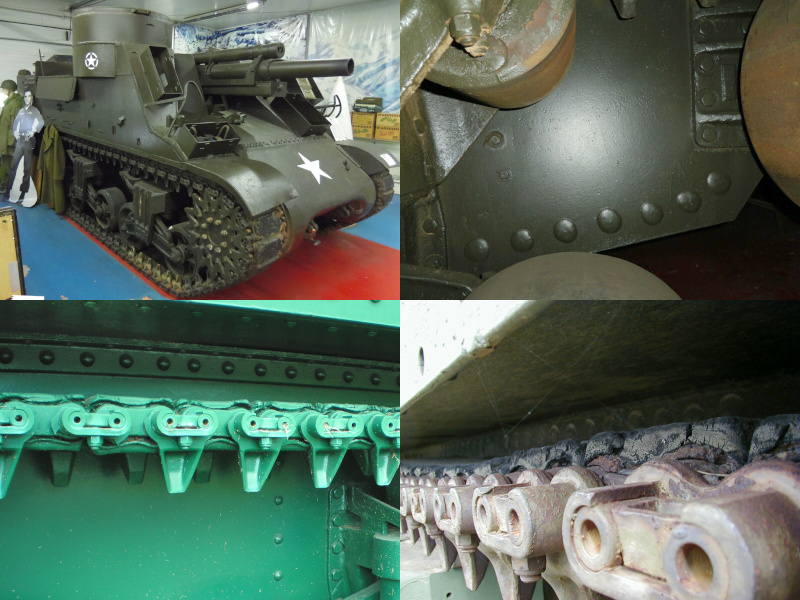
Something of a curiosity has been observed on four of the surviving 1944 production ALCO M7s. The lower hulls are welded together but the side plates are also seen with what we had been referring to as "melted rivets" for want of a better term. The photo at the upper right shows these on SN 3248 on display at the Russell Museum in Illinois. At first glance, we had thought that they might have been assembled riveted lower hulls left over from 1942/43 production, and that they had been reworked by welding so that they could be recycled for use in the 1944 program. Not being conversant in metal working, we had assumed that the welding process had "melted" the rivets. However, a closer look at one example showed that the lower hull's belly plate and rear plate had not been pre-drilled for riveting so that the hull could not have been an original riveted assembly. In addition, the "melted rivets" that could be seen on the inside are not actually holding anything together with angle brackets; they are simply plugs that are almost perfectly round blobs about the same size as rivets. We have not come across any ALCO documentation about this but have had a number of opinions, with the most likely coming from author Kurt Laughlin who thinks that the side plates were existing drilled plates on which the rivet holes were filled with weld metal so that they could be used to complete a welded hull assembly for the 1944 program. To try to explain further, the photo on the lower left shows an M3 Lee and illustrates how the rivets at the top of the lower hull were driven through an "L" bracket which was in turn attached to the sponson plate. The photo on the lower right is of the M7 in Seneca, Kansas and shows how the "plugs" are not driven through a bracket and also shows that the top of the lower hull is welded to the sponson plate. Sorry to say, only the first 3 digits of the Seneca's Serial Number can be read from the left rear tow lug - 325_. Even so, this would indicate September 1944 production. We do know that the entire SN of the M7 at the Russell Museum is 3248 indicating September 1944 acceptance or made about 70 units before the end of M7 production at ALCO. The upper hulls of both the Seneca and SN 3248 show signs of having been recycled from the earlier program as well, in that the notches in the upper rear hull plates are filled in, as are the holes for the fuel tank compartment ventilating grilles, etc. on the engine decks. It strikes us as odd that pieces from the earlier program were being recycled a month before the 1944 program came to an end.
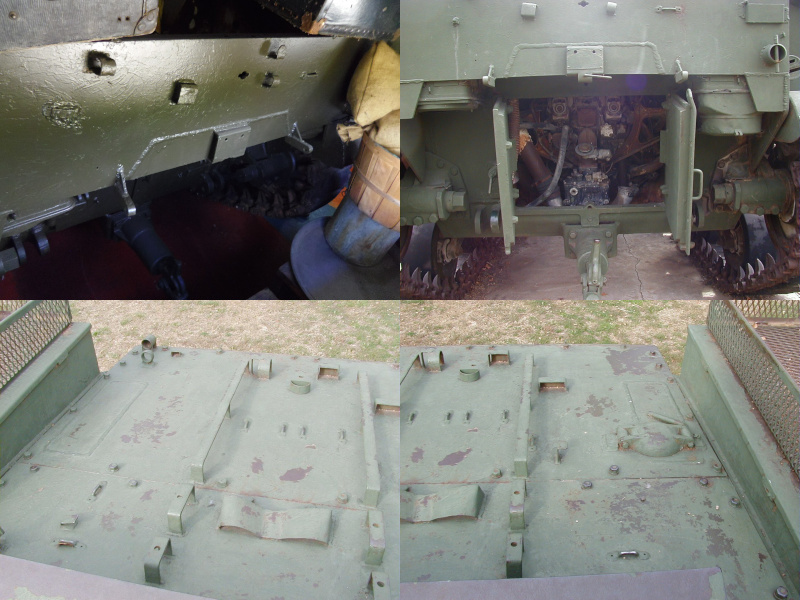
We were informed that the filled in notch on the upper rear hull plate of SN 2843 in the old Ft. Sill photo is not very visible. So, here it is on SN 3248 in Zion, Illinois in the upper left and SN 325X in Seneca, Kansas in the upper right. This was a simple expedient to adapt the old, notched parts, since the upper rear hull was designed to go straight across on 1944 and later production M7s as well as M4 and M4A1 Shermans. The lower photos show how the rectangular fuel tank compartment ventilating grille holes were blanked off to conform with the 1944 M7 engine deck configuration.
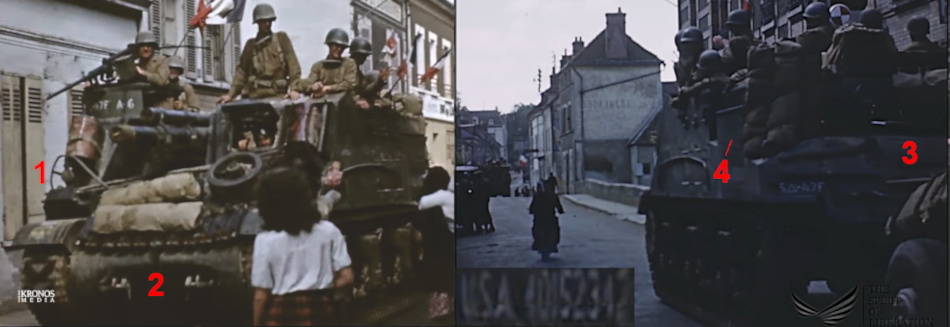
Returning again to France in the Summer of 1944, the 5th Armored Division landed at Utah Beach starting on 24 July 1944 and began combat operations as part of the newly activated Third US Army on 2 August just as Operation Cobra broke the German lines in the Cotentin Peninsula. The division drove south "through Coutances, Avranches, and Vitré, and across the Mayenne River to seize the city of Le Mans, 8 August. Turning north, the Division forged the steel ring around the Germans in Normandy by advancing to the edge of the city of Argentan on 12 August- 8 days before the Argentan-Falaise Gap was closed. Turning Argentan over to the 90th Infantry Division, the 5th Armored advanced 80 miles to capture the Eure River Line at Dreux on 16 August." Hollywood director George Stevens served with the Signal Corps during WW II, and his "SPECOU" [Special Coverage Unit] shot some raw color footage of the 5th AD's 47th Armored Field Artillery Battalion as it moved through a French city cheered on by liberated citizens. With some effort, Pierre-Olivier "found" the town using Google Street View. The scene was shot on the Rue Saint-Martin in Dreux, not long after the city was taken by CCB, 5th AD, so 16 or 17 August 1944. What caught our eye was a Priest named "America" "A-6" that has features identifying it as an M7B1. As it passes, the Registration Number can be read as USA 4015234- with just the final number unclear. In any case, even without the last number, the RN indicates an M7B1 produced in May 1944, so this unit was shipped overseas quickly and was in service with a combat unit about 2 1/2 months after it rolled off the line at Pressed Steel Car, a fairly impressive feat. In the front view, the "low" position of the head lights (1) and the sharp-nosed E8543 differential housing (2) are indications of a 1944 production M7 or M7B1. In the rear view, the angle and the extended down shape of the upper rear hull plate (3) is typical of Shermans and Priests with Ford engines. Note that the stowage bin (4) is smooth with no louvers, since the Ford V8 engine did not generate the heat of the Continental Radial and therefore did not require the additional ventilation. We would mention that another Priest rolls by in the Stevens footage "B-6" and it can be seen as a 1943 production M7, so it would seem that the 47th AFA Bn might have been equipped with both M7s and M7B1s. Some other SC footage was brought to our attention which shows another M7B1 named "All American" "A-10" with tactical markings denoting the 71st AFA Bn, 5th AD. This film is undated but from the context of the other footage in the segment, it appears to have been taken between the 14th and 16th of August as the 5th AD advanced from Argentan to Dreux. It seems safe to assume that these Priests landed with the 5th AD in late July and likely took part in their battalions' first fire missions in early August.
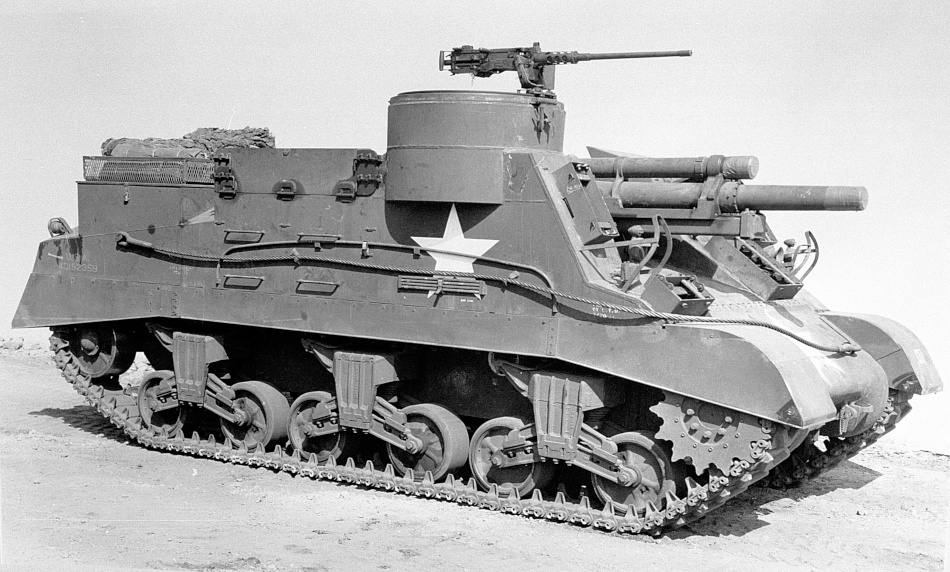
The 500 HP Ford V8 engine was the US Army's preferred tank power plant and consequently an order was placed for Priests powered by the Ford engine. These were given the nomenclature "M7B1." According to a "Development History" of the type, "At the request of Army Service Forces, 70% of all 105-mm Howitzer Motor Carriages built in 1944 were equipped with Ford G.A.A. V-8 gasoline engines." Going by the official production figures, this was not quite the case. The original M7B1 Production Order T-10154 was for 628 units, but this appears to have been supplemented by an additional order for 494 units which was eventually cut back to 198. Thus, the total number of M7B1s manufactured amounted to 826 units, with 664 produced in 1944. Meanwhile, 500 M7s were manufactured in 1944. In any case, Pressed Steel Car began M7B1 production in March 1944, the same month that ALCO restarted M7 production. Above provides a right front view of a May 1944 M7B1, Serial Number 3896, USA 40152359 as photographed at the General Motors Proving Ground in September 1944. As best we can tell from the limited amount of historical reference, the appearance of this unit is typical of the M7B1s produced by PSC from start to finish. The "Development History" describes the M7B1 as "based on the welded chassis of the Medium Tank M4A3 constructed of soft plate to give minimum ballistic effectiveness of one-half inch rolled homogenous armor." We interpret this to mean that the plates of the lower hull assembly were dimensionally the same as the M4A3, that is 1 1/2 inches thick on the sides and rear, but were made of soft plate, not armor. No explanation is offered for the use of soft plate, but we assume it was to reduce weight. The upper hull was assembled using 1/2-inch armor plate, except of course for the differential housing which was the same E8543 casting as used on Second Generation Shermans.
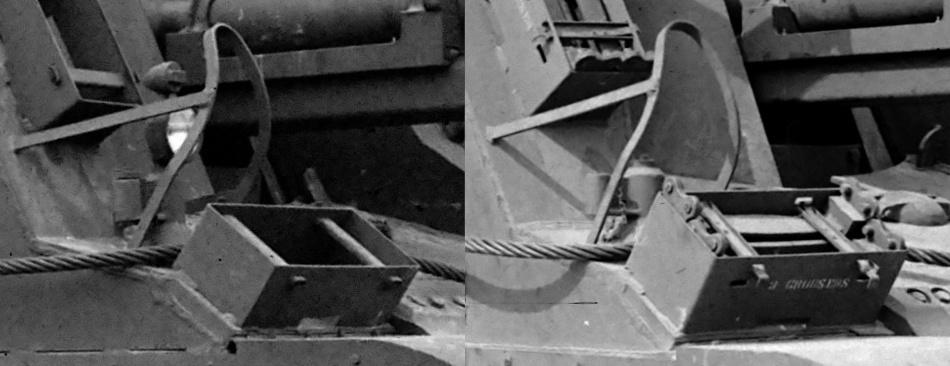
Here we have a side-by-side comparison of the grouser boxes seen on the M7B1 on the left and the 1944 ALCO M7 on the right. One would think that Pressed Steel Car and ALCO would have used the same grouser boxes in the interest of standardization, but to our eyes, the M7 boxes appear to be an inch or so higher. They also include the additional holes. We hope to get some measurements in the future and will report back.
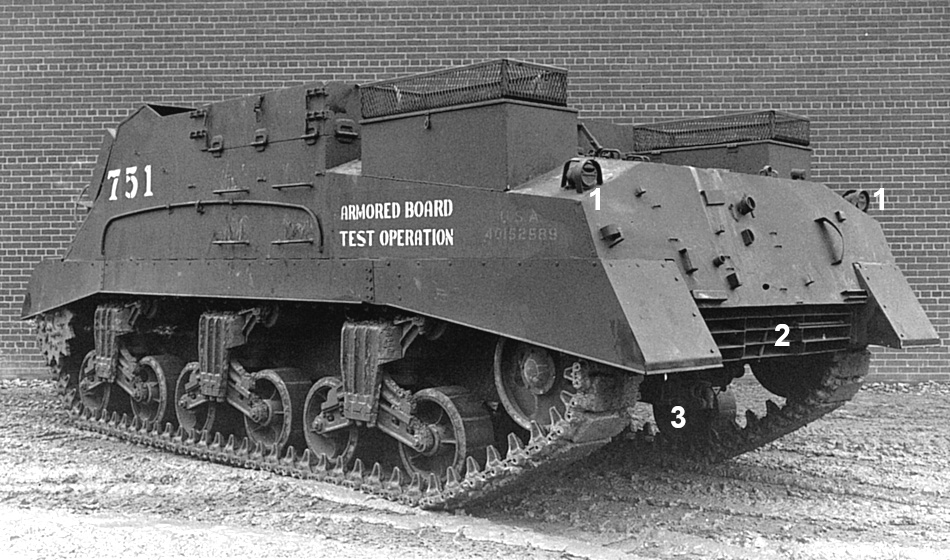
Here we have a rear view of USA 40152589 (September 1944) which was used in Endurance Tests by the Armored Board at Ft. Knox in late 1944. As mentioned earlier, the rear stowage boxes were not louvered for air intake as on the 1944 M7, and this provides a decent recognition feature when looking at certain period photos. The sides at the rear were not "jogged in" as on the M7 but went straight back. Thus, there was room for the taillights (1) to be placed on the upper sponsons as seen here. The upper rear hull plate was angled as opposed to the vertical orientation on the M7. It also extended down further to provide a measure of protection to the engine's radiators. The M7B1 used the same sheet metal type of exhaust deflector (2) as the M4A3 Sherman. It is thought that the M7B1 was factory installed from start to finish with the same "short" trailer towing pintle (3) as used on Second Generation Shermans.
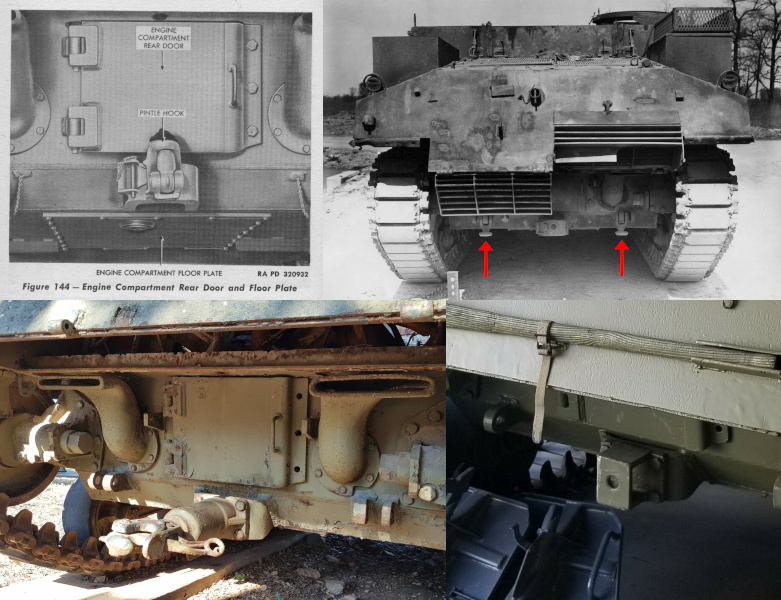
As mentioned earlier, it is our impression that all of the ALCO M7s were built with the original "long" trailer towing pintles factory installed. Regarding the M7B1, we don't have a lot of reference but think that they were factory installed with the "short" pintle as seen in the Tech Manual illustration in the upper left, and in a close up (sans pintle) of an APG photo of M7B1 SN 4366 (December 1944) in the upper right. The original "long" pintle could get bent up in service causing a misalignment of the rear engine mount and/or making it impossible to open the engine access doors. As a result, the pintle was shortened and the redesigned item was ordered to be factory installed as standard equipment on Second Generation Shermans. We have not come across any requirement regarding the M7B1s but think that this was used on them as well. Some doubt is cast because of the 90 or so surviving M7B1/B2s, not many have what we think was the factory installation of the short pintle. Several are installed with the "long" pintle as seen in the lower left on the M7B2 (SN Unknown) at Camp Mabry, Texas. Others are noted with a mounting configuration for the "short" pintle that is "two tiered" as seen (without pintle) on the M7B1 at the Pivka Museum in Slovenia in the photo on the lower right. We can only guess that when these units were rebuilt in the post war years and/or when some were converted to M7B2s, these changes were made. Furthermore, counting heads suggests that M7B1 production at PSC started with double rear towing lugs, but was changed to single lugs in January 1945, since the new T-shaped towing shackles (arrows) only required one lug. A very limited counting heads suggests that only about the last 100 M7B1s were produced with the singles.

Modification Work Order G1-W22 was released in April 1945 and applied to all Shermans or variants with Ford engines, including the M7B1. The purpose was to, "Eliminate possibility of ground bursts damaging the radiators by replacing sheet metal exhaust deflector with one made of armor plate strips." As usual with mods, "This modification should be applied to all of the subject vehicles in or destined to be shipped to theaters of operation that are not so equipped." Furthermore, no vehicle was to be shipped overseas without this mod after 15 May 1945. Due to its late date of issue, we doubt if it was ever factory installed on any M7B1s and can't say that we have seen it in any M7B1 WW II overseas photos. Quite a few surviving M7B1s and B2s are equipped with the armor plate exhaust deflector modification, such as the M7B1 on display in Hamilton, Montana. This Priest has "USA 40172501" painted on, and we suspect that it may be the original Registration Number. If so, it indicates January 1945 production at PSC. The drawing on the right provides measurements for the positioning of the pioneer tools. Basically, the addition of the deflector's hinges forced the relocation of the crowbar 3 1/2 inches up from the bottom edge of the upper rear hull plate. We consider the diagram to represent the "official" arrangement of the tools but would note that a number of surviving M7B1s and M7B2s are seen with the shovel positioned further to the right. The Hamilton M7B1 shows the alternate location of the shovel fittings.
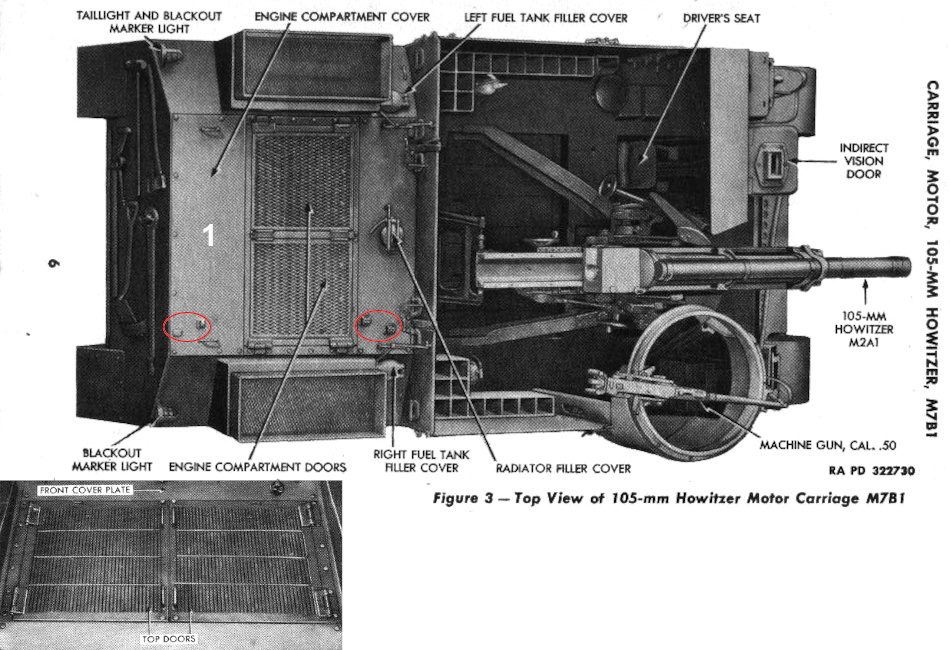
This overhead view from the M7B1 Technical Manual shows the vehicle's engine deck layout including the left and right fuel filler covers plus the radiator filler cover in the center. We believe that the engine compartment doors were the same as used on M4A3 Shermans although we admit that we have not had the opportunity to closely examine or measure any so far. The TM illustration seems to give a false impression of the appearance of the grating of the doors, judging by surviving examples. However, there is another illustration (inset) on page 313 of the TM which shows what we think was the actual look of the grating on the doors, that is, identical to M4A3 doors. Note that the rear "Engine Compartment Cover" (1) is a one-piece plate. As with the M4A3s, in order to make it easier for crews to remove, this appears to have been changed to a two section cover at some point not long after the start of production. The fittings (circled) held the bore brush staffs although the TM gives their location as "In bracket on rear fighting compartment wall." (This appears to have been copied verbatim from the M7 TM.) In any case, in order to open the right engine deck door, it would have been necessary the remove the staffs.
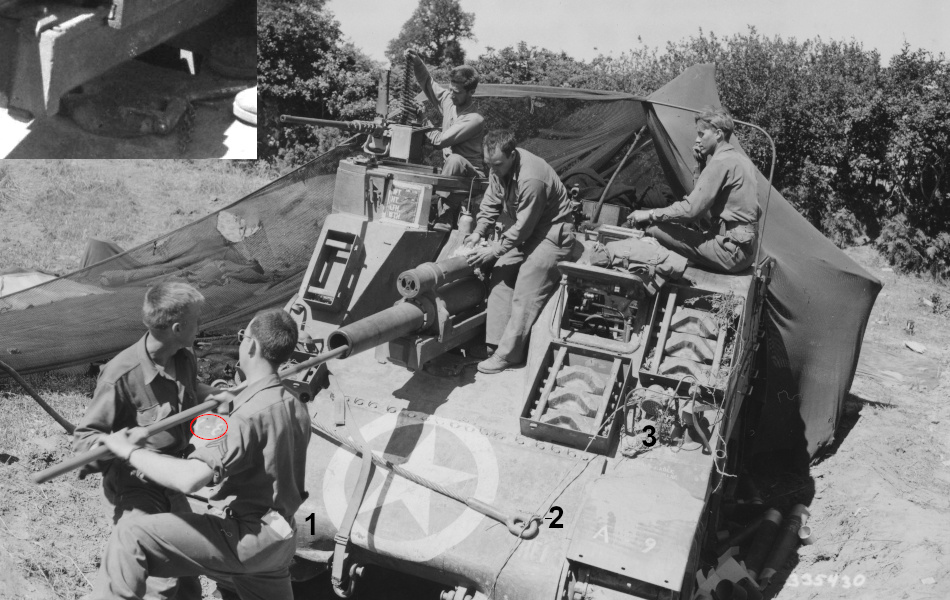
This Signal Corps photo is dated 13 August 1944 and shows the crew servicing their "105-mm self-propelled howitzer" during "the Siege of Brest." The caption identifies the men from left to right as Pvt. John Siirila, Cpl. Robert Silverman, Pvt. Ed DeSimone, Pvt. Bert Lavare, and Sgt. William Entrekin. The unit is identified as "83rd Field Artillery Battalion, 6th Armored Division." According to the unit AAR, the 83rd Armored Field Artillery Battalion was part of the 5th Field Artillery Group, and not one of the 6th AD's organic AFA Bns. The battalion landed at Utah Beach on 25 July and on 1 August was attached to CCA of the 6th Armored Division. A CCA map dated 12 August shows that the 83rd was positioned near Plabennec a few miles northeast of Brest and was providing artillery support in conjunction with the previously mentioned 212th AFA Bn of the 6th AD. The photo obviously shows a 1944 production Priest, but from this angle, it is practically impossible to determine if it is an M7 or an M7B1. The grouser boxes can be seen with only one hole for each of the retaining bars, which we have interpolated would make this an M7B1. In addition, this particular image is unusual since it was possible to zoom in on the armored fuel filler cover (inset), where it appears that the center hinge barrel has no tab but is welded directly to the hull. If so, according to the theory we presented earlier, that would also make it an M7B1. The AAR does mention that just before being deployed to the Continent, the battalion had moved to Lyme Regis, Devonshire where from 12 to 17 July, it "calibrated the new self-propelled 105s." Unfortunately, the AAR does not include any identification hints such as "M7B1" or "Ford engine". The marking "X-8" (circled) can be seen on the right front fender. We would make a wild guess that the whole marking might have been "3A [3rd Army]-X [separate formation]-83 F [83rd AFA Bn]." And of course, the Priest was vehicle "A 9" within Battery A. Note the early type E8543 differential housing with the cast in steps (1). The cable clamp (2) on the differential housing became a standard fixture on 1944/45 Priests, although it is not present on some early 1944 production M7s. "A 9" can be seen with a siren (3). From the available evidence, we would simply observe that it appears that the manufacturers transitioned to an automobile type horn early on.
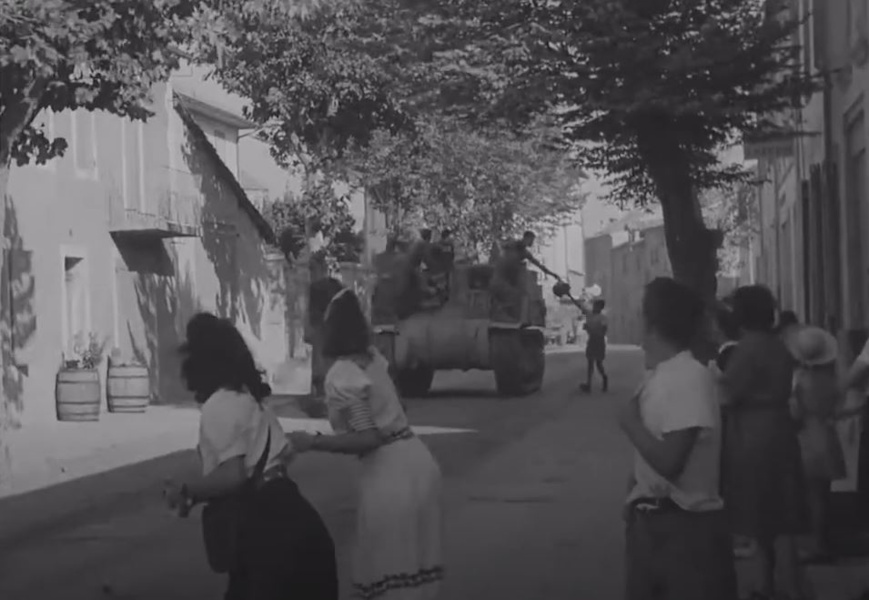
The US 7th Army was tasked with the invasion of southern France, code named Operation Dragoon. The objective was to establish a beachhead east of Toulon from which the US VI Corps would push north up the Rhone Valley, while French Army B would capture the ports of Toulon and Marseille. The VI Corps assault on 15 August 1944 was made by three veteran US infantry divisions, the 3rd, 36th, and 45th. Each was assigned an armored field artillery battalion from the 6th Field Artillery Group. For instance, the 93rd AFA Bn, a veteran of the Italian campaign, was attached to the 36th (Texas) Infantry Division, which landed on the "Camel" beaches in Le Dramont, east of Saint-Raphaël. The 93rd's souvenir history states that their M7s were waterproofed and transported to the beaches by LCTs. There is no mention of "fire afloat." The records of the 36th ID note that the division's organic Field Artillery Battalions that came ashore on D-Day were equipped with towed 105s lashed to DUKWs, "prepared to fire." In any case, by 1200 hours, the 93rd AFA Bn had one battery in action ashore. It was reported that "only two [personnel] casualties were suffered in the landing" but further inland one M7 was destroyed "by a direct hit in the early hours of the afternoon." We don't know of any photos or film clips showing 93rd AFA Priests landing on D-Day, but here we have a screen capture from some raw Signal Corps footage which shows a single M7 making its way down the street of a town in southern France that we have not as yet been able to identify. In the succeeding footage, joyous citizens welcome GIs whose Jeeps have tactical markings indicating the 3rd Battalion of the 142nd Infantry Regiment, 36th ID. We suspect the Priest, which appears to have a shallow pulpit, may have been a unit of the 93rd AFA Bn. Another possibility is that the M7 may have been serving with the Cannon Company of the 143rd IR, 36th ID. The 143rd's AAR for 29 August records, "some of Cannon Company's M-7 mounts were momentarily cut off from our troops but were able to regain contact after a fierce fire fight." There are a few other references in the records of the 143rd IR that suggest that some M7s were still in service with its Cannon Company at least up to December 1944. We would note that the M7s which deployed from Italy would have been 1942 or early 1943 production units.
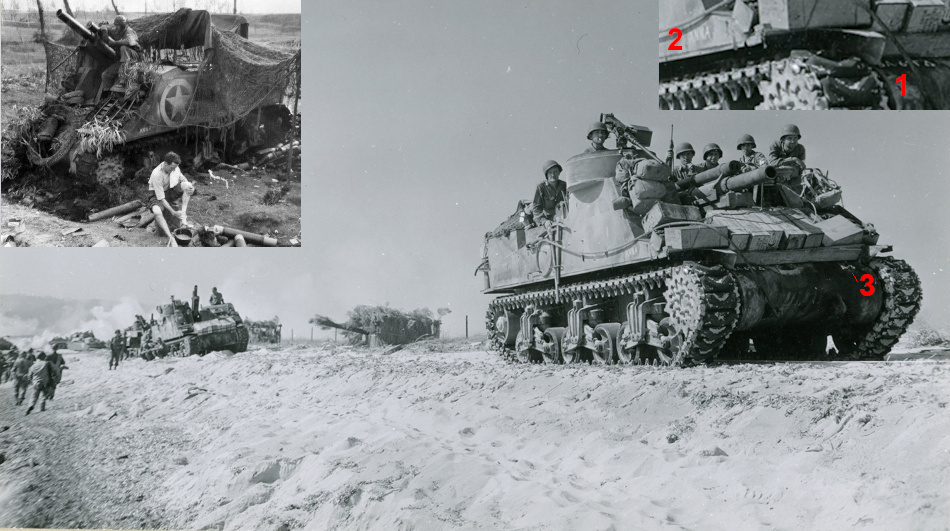
We have not come across the caption of the photo above but comparing it to other Op. Dragoon photos, believe it may show a few M7s moving inland shortly after disembarking on D-Day from the 3rd Infantry Division's Alpha Beach landing zone in the vicinity of Cavalaire sur mer. The tactical markings on the lead Priest are partially obscured by the tow cable, but what can be read appears to be "5A-6_ F Delta" (1). The name "ANNA" (2) is also visible, along with "A-3" (3). "ANNA" rang a bell that we were able to cross reference to a Signal Corps photo (inset) taken in Nettuno [near Anzio], Italy, February 2nd, 1944. The caption reads in part, “Pvt. Francis W. Maguire, Harvard, Ill., of the 69th Armored Field Artillery Battalion, A Battery, washing his feet during a lull between fire missions." The 69th AFA Bn was one of the units of the 6th Field Artillery Group (along with the 59th and 93rd AFA Bns) that had served with the 5th Army in Italy. The Group had been assigned to the 7th Army for Operation Dragoon, but perhaps there had not been time to change ANNA's "5A" tactical marking to "7A"? In any case, the 69th AFA Bn was attached to the 3rd US Infantry Division for the assault. Note that some of the cannoneers can be seen wearing the American flag armbands that were widely distributed for the invasion. The smoke on the far left was likely generated by a detail of the 3rd Chemical Battalion at the actual unloading site. The gun emplacement in the center of the photo may have been a dummy. The Priests are carrying quite a few K-Ration crates, perhaps intended to be dropped off inland at one of the various dumps set up by the 36th Engineer Beach Group? The first two M7s can be seen with one-piece differential housings, shallow pulpits and no field or modification kit armor protection for the exposed 105mm rounds. We would have expected that a wading trunk and splash plate might be visible on the lead M7. Perhaps these units were de-waterproofed immediately upon landing?
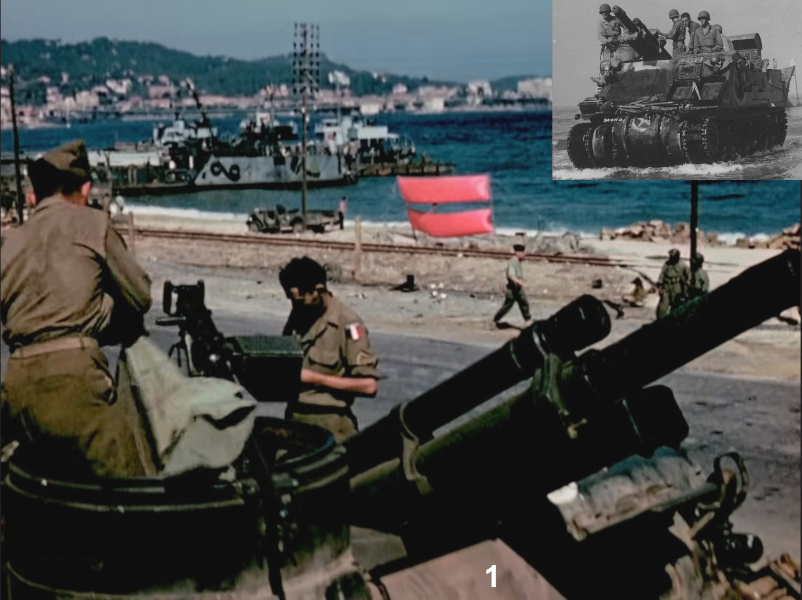
Major General Lucian Truscott, the VI Corps Commander, had requested that a Combat Command from an armored division be assigned to VI Corps as part of the assault. No US armored divisions were available, but the French reluctantly agreed to provide Combat Command Sudre, named for its commander, Brigadier Général Aimé Sudre, from their 1ère Division Blindée but only until D+3. CC Sudre landed on 16 August (D+1) in the area of Delta Beach which had been secured by the 45th ID on D-Day. The major elements of CC Sudre were the 2e Régiment de Cuirassiers [tank regiment], 3e Bataillon de Zouaves [mechanized infantry], and I/68e Régiment d'Artillerie d'Afrique with 18 M7s. It is thought that the screen capture shows a Priest of the 1er Groupe, 68ème RAA shortly after coming ashore. The records of the 1ere DB note that it was "the first artillery unit to debark in southern France." Maréchal des Logis (Sergeant) Joseph Gonzales states that the 1er Groupe landed at 8:00 am on 16 August at La Nartelle Beach. In the days that followed, CC Sudre screened the northern flank of the beachhead "maintaining contact with the American 3rd Division in and about Brignoles and along Highway 7 toward Aix-en-Provence." It soon became evident that the Germans were not going to mount a counterattack against the beachhead, so on 20 August, the unit was returned to the 1ère Division Blindée for the assault on the ports, the highest priority objective of the invasion. Sorry to say, this image from the film is the one that shows the most detail, so not much can be seen of the M7 except that it has a deep pulpit. The gun appears to be elevated over a splash plate (1) that has been noted in a few period photos of M7s modified for wading in the MTO. The inset shows the plate on "Apollo" of the 69th AFA Bn during a practice landing in Italy about two weeks before Op. Dragoon. This sort of thing would directly affect the fighting capabilities of the vehicle, so it seems likely that the crew or specialists would have removed the plate along with any other wading impedimenta at the earliest opportunity. One of the cannoneers is wearing a French flag shoulder patch or écusson. Maréchal des Logis Gonzales related "Everywhere the population shows us their immense joy at being FINALLY liberated, and by the FRENCH." We might note here that Operation Dragoon was a controversial decision opposed by proponents of a continuing Italian campaign, led by British Prime Minister Winston Churchill. Some units of French Army B, redesignated French First Army on 25 September 1944, were veterans of the Italian campaign, while others were new units that had been formed and trained in northwest Africa. In the event, there was no way that the French Army would have agreed to continue to serve in Italy as opposed to fighting for the liberation of their own country.
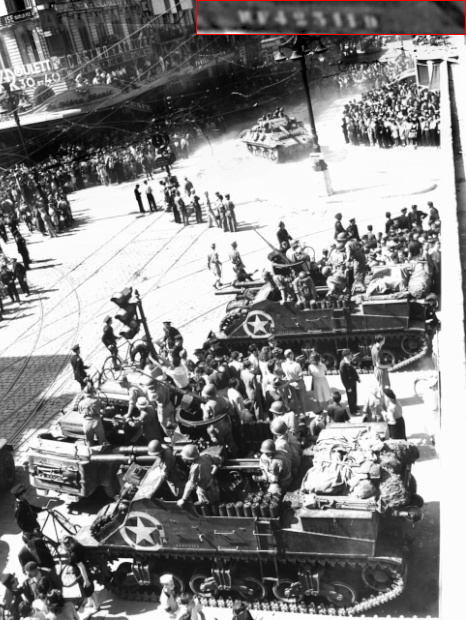
The invasion was accomplished with "an amazing degree of success and a minimum of casualties." Consequently, the II Corps of French Army B was ordered ashore several days ahead of schedule. The French Army commander, General De Lattre de Tassigny boldly determined to expedite matters by dividing his II Corps so that both Toulon and Marseille would be assaulted at the same time, each by two divisions. These were heavily fortified cities whose defenders (13,000 in Marseille and 18,000 in Toulon) outnumbered the attackers. Despite that, with ample naval and air support, and after much bitter fighting, the French compelled the surrender of both garrisons on 28 August, weeks ahead of schedule and with their port facilities mostly intact. The great prize was Marseille, the largest port and the second largest city in France. Eventually about 1/3rd of US troops and supplies would come into the ETO through the port. The photo above shows a scene from a liberation parade held in Marseille on 29 August. This was filmed in the Vieux Port area on La Canebière at the intersection of Cours Saint Louis. The 3rd Algerian Division, Combat Command Sudre and the Forces françaises de l'Intérieur [FFI] played leading roles in the fight for the city and proudly passed in review. The M7 in the foreground can be seen with the "Preparation for Overseas Movement" or "POM" code of "MF42311D" (inset). French sources have it that this indicates the 1ere batterie, 1er groupe, 68e Régiment d'Artillerie d'Afrique. Again, it can be noted that these M7s are not installed with any sort of armor protection for the exposed 105mm rounds. They do show the loops and fittings for the canvas cover, although the "top bow" is not present, at least not on the left-hand side. Step ladders, which appear to have been removable, can be seen threaded through the rear rungs on these Priests. We would mention that, in Normandy, Brittany and southern France, unit histories laud the FFI for the invaluable assistance they provided. General Alexander Patch, commander of the US 7th Army "estimated that from the time of the Mediterranean landings to the arrival of U.S. troops at Dijon, the help given to the operations by the FFI was equivalent to four full divisions."
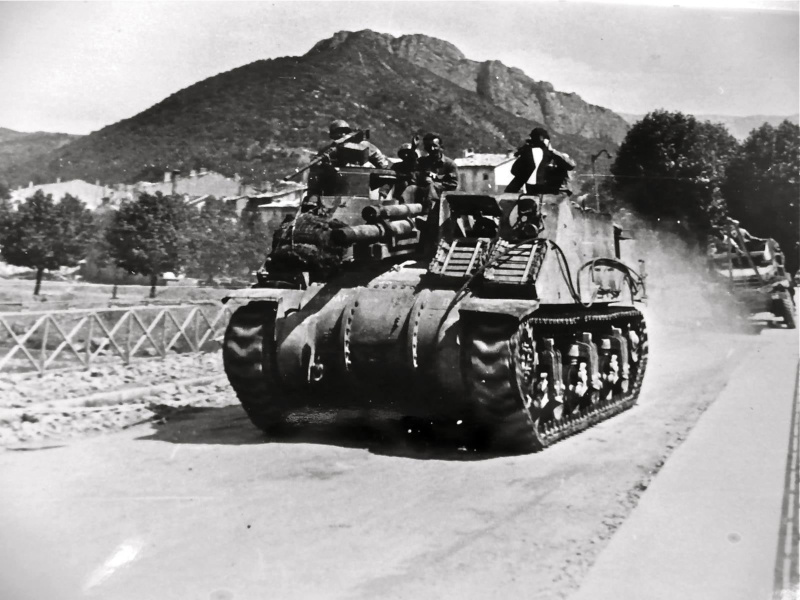
Gen. Truscott, the VI Corps Commander, did not have confidence that he would be permitted to retain CC Sudre, so during invasion planning in Italy he had his deputy commander, Brigadier General Frederick Butler, organize an ad hoc mechanized force that would be as close to an armored combat command as possible using available units of the VI Corps. Task Force Butler was composed of the 117th Cavalry Reconnaissance Squadron, the 2nd Bn ("in motors") of the 143rd Infantry Regiment, 36th ID, Companies B and C of the 753rd Tank Bn, Company C of the 636th Tank Destroyer Bn and the 59th Armored Field Artillery Bn. The planners had envisioned a methodical advance north from the beachhead, but Truscott wanted a mobile force on hand in the event an opportunity for exploitation should arise. He became privy to an Ultra decrypt that indicated that the German Nineteenth Army had been ordered "to retreat and establish a defensive line along more favorable terrain in the interior." With that in mind, Truscott ordered Butler to advance, and starting on 18 August, the Task Force set off up the Rhone Valley with the idea of blocking the Germans' line of withdrawal in a manner similar to that which was playing out at the time in Normandy. In the uncaptioned photo above, the unmistakable profile of the mountain, "Le Rocher de Neuf Heures", overlooking the town identifies the scene as at Digne les Bains about 75 miles north of TF Butler's starting point at Le Muy. On 19 August, "General Butler saw an opportunity to encircle the enemy at Digne by a flanking maneuver and a surprise attack." B troop of the 117th Cavalry plus a company of infantry supported by medium tanks and a large contingent of the FFI compelled the surrender of the 600-man German garrison. By the tactical markings on the differential housing, it is thought that the photo shows an M7 of B Battery, 59th AFA Bn making its way west over the "Grand-Pont" [bridge] at Digne on the evening of the 19th. By last light, most of TF Butler would be assembled at Sisteron a further 25 miles to the north. The 117th Cavalry Reconnaissance Squadron comprised the greatest part of TF Butler, and we would mention here that while the unit was in a staging area near Naples, their records for 18 July 1944 state that "E Troop received new guns. The M7 Self-propelled 105mm howitzers were a much needed replacement for the M8 75mm Howitzers with which we had been operating throughout the Italian Campaign." This was an unusual arrangement for a Cavalry unit, but the 117th appears to have been granted "special authority" to use their M7s to the end of the war. General Butler notes that on 22 August, the "Assault Gun Troop enjoyed the shoot of the day. The 105's were delivering aimed fire at enemy columns west of Loriol and at a range of 2500 yards. Firing high explosive and phosphorous these guns accounted for hundreds of vehicles setting them ablaze and sending occupants scurrying." Ultimately, Truscott's bold attempt to surround and destroy the German Nineteenth Army inside the "Battle Square" at Montélimar (21 -29 August) was foiled primarily by logistical issues. The planners did not anticipate that the VI Corps would make such a rapid advance, and did not have the ammunition, fuel and transportation necessary to affect the outcome. The damage inflicted on the enemy as a result of Operation Dragoon was significant to say the least. It is estimated that the German Armies in southern, central, and western France lost about 150,000 troops. Patch's 7th Army had advanced almost 400 miles in less than a month. The so called "Champagne Campaign" came to end on 11 September with the link up of the 7th Army with Patton's 3rd Army near Dijon. At that point, the 7th Army and the French 1st Army came under command of Eisenhower's European Theater of Operations (ETO). With thanks to Loïc Jankowiak.
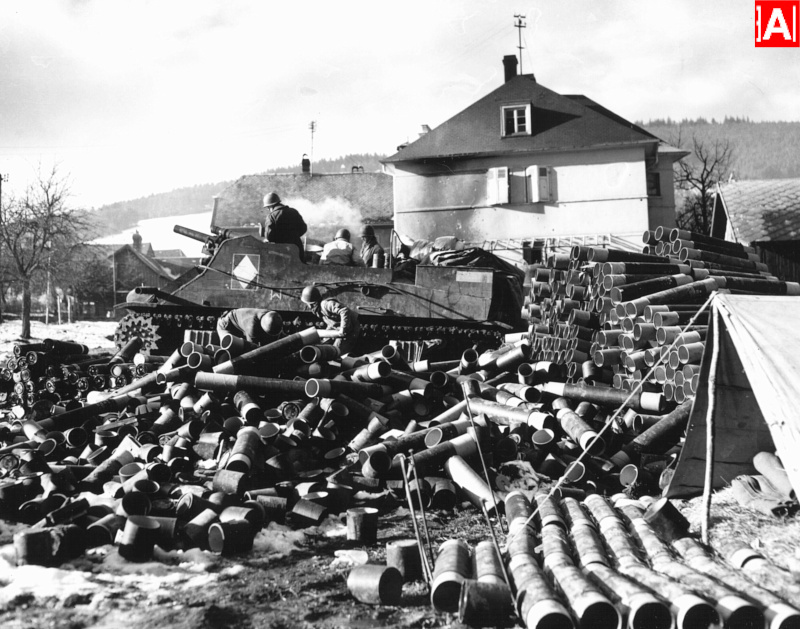
By mid-September 1944, logistical issues brought an end to the Western Allies' heady pursuit of the Germans across France and the Low Countries. Despite having suffered catastrophic defeats, the Germans recovered and managed to stabilize their lines along the entire Western Front. The 5ème Division Blindée embarked from Oran on 15 September and landed in southern France on the 21st. The 62ème Régiment d'Artillerie d'Afrique was a component of the 5ème DB and because of their late arrival, some of the gunners of the 4ème Batterie were worried, "The advance of the Allied troops is so fast that, for a moment, we lose hope of ever fighting." As it turned out these men would see plenty of action in the Vosges Mountains and in Alsace, where they would endure mud, snow, and extreme cold while trying to move their M7s and support vehicles through the mountainous terrain. The 3 Groupes of the 62ème RAA are reported to have engaged in their first fire missions on 3 November in support of an attack by Groupement Bonjour of the 3ème Division d'Infanterie Algérienne against an enemy position near Le Haut du Tôt, a village in the Vosges Mountains. The Signal Corps photo above shows what appears to be a 1942 production M7 that the caption identifies as of the "5th Div. Blindee, 1st French...in Kaysersberg area" on 17 December 1944. As the number of units deployed overseas increased, the supply of artillery ammunition fell well short of demand, and SC256262 was part of a series aimed at the US Home Front that illustrated "why ammunition production must be stepped up to supply the needs of modern warfare." The tactical marking painted on the side of the vehicle and shown in the inset, identifies this Priest as with the 6ème Batterie, 62ème RAA. Kaysersberg was actually in German hands on 17 December. The After Action Report of the 2ème Groupe, the parent formation of the 6ème Batterie, indicates that the unit arrived in Aubure, 15 kms north of Kaysersberg on 7 December and indeed, we have been able to determine that the photo was taken in the garden of a house located on the Route de Ribeauvillé in Aubure. The 2ème Groupe was attached to Combat Command 4 of the 5ème DB and supported attacks on Orbey and Kaysersberg until 18 December.
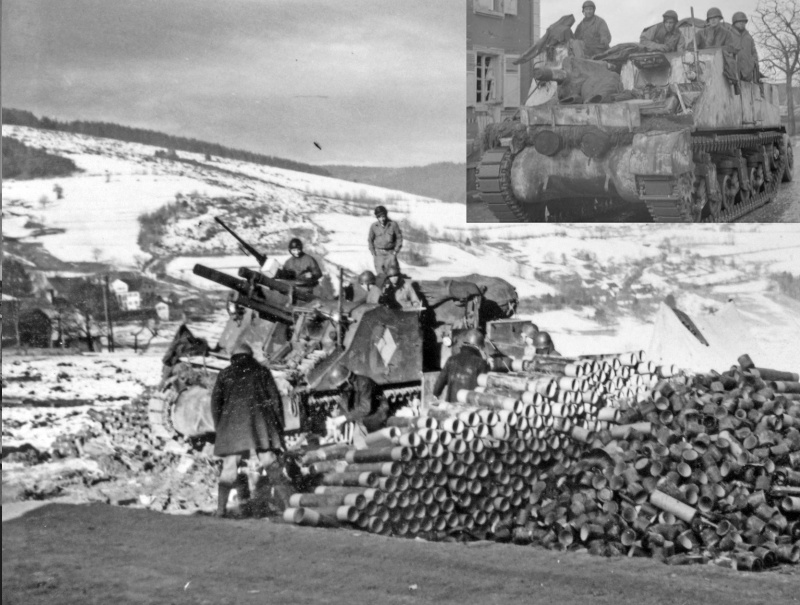
Here we have the next photo in the "produce more ammo campaign" series, SC256263. The caption is again dated 17 December 1944 and is identical to that of SC256262 above. Again, we take the location to be Aubure based on the group of buildings seen in the background which we have been able to identify as the Sanatorium Bethel. It is assumed that "les automoteurs M7" in this series of photos were within sight of each other, but unlike the Priest in the previous image, this is another example that can be seen to have been retrofitted with a side door. In his study of French armor, Pierre-Olivier does not think that the practice was widespread, "I have only seen "a few" of these side door jobs in the 62ème RAA, for instance, on Marignan II and Rocroi II." The inset shows what appears to be the same Priest as in the main photo judging by several similarities including the lone remaining (front) section of the Grant type sand shield and the "broomstick" by the head light. It can be noted that the door was hinged along the bottom like the one shown earlier in the Base Shop at Livorno. Our analysis suggests that the inset photo was taken in Riedwiehr, 10 kilometers north-east of Colmar. The AAR of the 2ème groupe states that the 6ème batterie was in Riedwihr on 27 January, and that about a week earlier, "the tanks were painted in white to blend into the snow that accumulates more and more".
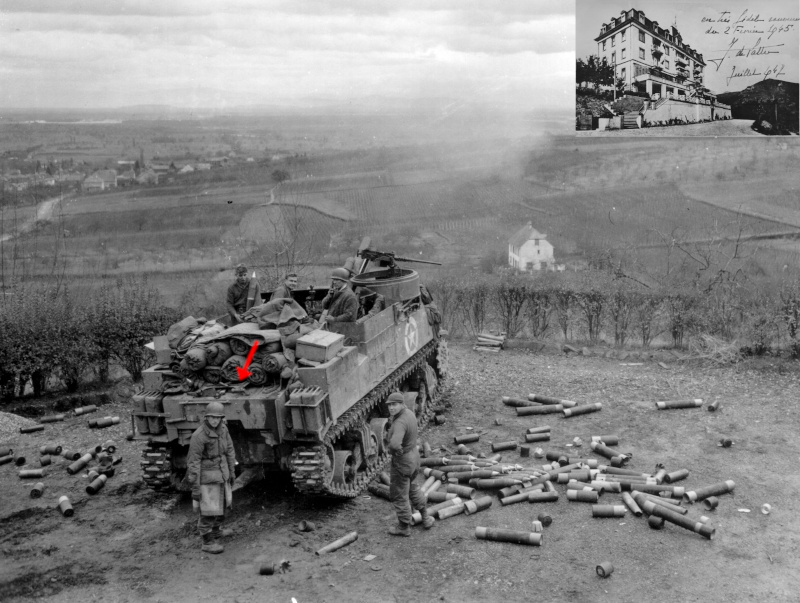
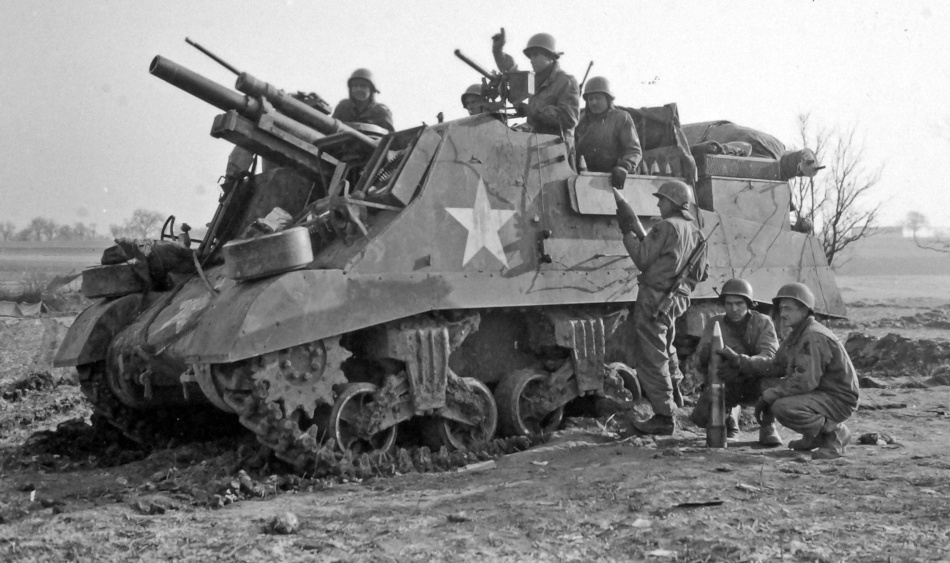
The photo above is captioned, "105mm howitzer mounted on M7 mount, fires its first round at the enemy since going into action on this 7th Army front in France, 25 Dec 1944...#2 gun section, Battery A., 493rd FA Bn., 12th Armd Division." This Signal Corps photo appears in the 493rd's "Pictorial History" where the date is given as December 5, 1944, the location as Weisslingen, France and the event is described as a milestone - "the Division's first combat round...the first of over 44,000 rounds of 105 M.M. ammunition expended by the Bn during the next 150 days." The 12th AD arrived in the UK in early October 1944 and was stationed at Tidworth Barracks where, "Vehicles and other supplies began to pour in from large warehouses scattered over the English countryside. Peeps, 6x6's, half-tracks, and M-7's began to roll into Tidworth with regularity. They were immediately checked and made combat serviceable. Above all, the sight of Ford tank motors brought great delight to all and especially to motor sergeants and drivers who well remembered the old radial motors." We mention this because, although we have not as yet found definitive supporting documentation, we suspect that the three AFA Bns of the 12th AD may have been entirely equipped with M7B1s, at least at first. In the area of "counting heads", we might observe that we have seen over 20 photos of 12th AD M7B1s in the ETO, but not a single in theater shot of a 12th AD M7. In any case, the division landed at Le Havre, France on 11 November, and convoyed cross country until it arrived in Luneville on 2 December. The 12th AD was assigned to the XV Corps on the northern flank of the US 7th Army and on 5 December, the division's three armored field artillery battalions became the first units ordered into action, "the 493rd and 494th went to an area near Drulingen to support the 44th Infantry Division, and the 495th moved to the vicinity of La Petite Pierre to support the 100th Infantry Division." This M7B1 is one of the few Priest "combat shots" that shows the factory sand shields "still" installed. It might be assumed that the man standing behind the retrofitted .30 caliber machine gun is the "Chief of Section."

This Signal Corps photo appears in "Thunderbolt: The History of the Eleventh Armored Division" with the caption, "Artillery lines the road on the outskirts of smoldering Obernust, Germany." Unit records indicate that all three of the division's armored field artillery battalions, the 490th, 491st and 492nd passed through that area on 1 April 1945 supporting the advances of their respective combat commands. The 11th AD arrived in the UK in mid-October 1944. By the end of November, the division was almost completely equipped and "Opportunities had been provided for every unit to fire all weapons newly received, including the artillery 105's and the 76mm tanks." The 11th arrived in France in early December. It was intended that the division would go into Brittany to continue its training under combat conditions by assisting in the containment of the German garrisons of the bypassed ports such as Lorient and Saint-Nazaire. However, with the German attack in the Ardennes, the division's mission was changed, and it raced east to the Battle of the Bulge. The AFA Bns are reported to have fired the division's first shots in anger on 30 December. The unseasoned 11th AD was attached to the 3rd Army and in the eyes of its irascible commander, George Patton, it did not perform up to his standards. By the spring of 1945, the veterans of the 11th AD had mastered the art of blitzkrieg warfare, and "became a very fine division" according to Patton. Here we see a column which includes five Priests towing the older M8 Ammunition Trailers. The fully enclosed M8 trailer was manufactured by John Deere & Co. and had the capacity to carry 42 rounds of 105mm ammunition. It was classified as Limited Standard in November, 1943 and was superseded by the open-topped M10 Ammunition Trailer. At least three of these Priests can be identified as M7B1s. The Army considered the Ford GAA V8 engine to be the best tank power plant and strove to supply its fighting forces with as many Ford engined Shermans as industrial conditions would permit. While we don't as yet have any facts and figures, based on photographic evidence, it would appear that a good number of the 664 M7B1s produced by Pressed Steel Car in 1944 were shipped to the ETO and issued to the AFA Bns of the later arriving Armored Divisions such as the 8th through the 14th and the 16th. Furthermore, the evidence suggests that the earlier arriving ADs, the 2nd through the 7th, were predominantly issued M7s and later on received both M7s and M7B1s to replace combat losses. For some reason, 1944 production Priests were built with sand shields which most crews promptly removed. Note that the M7B1s in the photo are equipped with extended end connectors which of course required removal of the sand shields. The 11th AD AARs report that "Steel “duck bills” were added to all full track vehicles for the purpose of widening the tracks and providing more traction." In the case of the 492nd AFA Bn these were stated to have been installed on the 23rd of December during a stop at the Foch Barracks in Laon, France about 130 miles west of Bastogne.

This Signal Corps photo is dated "26 Feb 45" and captioned, "A tank [sic] of the 10th Armored Div., US Third Army, crosses the Saar River over a ponton [sic] bridge at Saarburg, Germany. CCA." Readers might recall that M7, SN 2843 at the U.S. Army Field Artillery Museum honors the 420th AFA Bn and indeed all of Combat Command B of the 10th AD which played a key role in the defense of Bastogne. Of course, the "CCA" in the SC caption refers to Combat Command A which along with the rest of the 10th AD defended the right shoulder of the Bulge in northern Luxembourg while CCB fought at Bastogne. There are no visible markings on the M7 in the photo, but we may be able to identify the unit as the 419th AFA Bn based on entries in the battalion's After Action Report, "On Feb 25, the 419 took its place in the column of CCA, and crossed the Saar River at Serrig on Feb 26. The 419 fired very effectively in support of the Division’s columns in the attack northward toward Trier." While the caption gives the location as Saarburg, Pierre-Olivier had no trouble using Google Street View to confirm that the site of the pontoon [treadway] bridge was actually 4.5 km south at Serrig, since the area has hardly changed in the last 79 years. In any case, the "tank" can be identified as an M7B1. Note the flat block rubber tracks with extended end connectors. In late December 1944, the 419th AAR notes that "The steel tracks of our M-7s slid like skates on an ice rink." In early January 1945, as the unit reorganized and refitted near Metz, "Steel tracks were removed from the M-7’s, and replaced by rubber tracks." However, there is no mention of EECs installed at that time. We would guess that the 419th AFA Bn was equipped with M7B1s either partially or entirely, but the AAR never hints at it, always referring to their mounts as "M-7s". The M7B1 can be seen towing an open-topped M10 Ammunition Trailer. These are generally seen covered with tarps. Because of the location of the Priest's towing pintle, the ammo trailers are noted with a downward tilt at the front.

The 16th Armored Division, the last US AD activated during World War II, arrived at Le Havre, France in mid-February 1945. After drawing equipment and organizing, the division was placed in theater reserve in northern France. As the Third Reich collapsed, the division was ordered forward and was assigned to occupation duty in Nuremberg. A sizeable German force occupied Czechoslovakia, and in early May, Patton's Third Army was ordered to advance into the country and defeat them in tandem with the Soviets attacking from the east. The Third Army's primary objective was Pilsen (Plzeň), the most important city in western Bohemia. At the time, the Third Army was the largest it would ever be with 18 divisions and over 540,000 troops, including a number of veteran outfits operating at their peak. Nevertheless, from his memoirs, it would appear that Patton specifically selected the untried 16th AD to have the honor of taking Plzeň, "We were very anxious to get the 16th into a fight before the war stopped, and they were very anxious to get there." We have not been able to identify the source of the above photo, but would be pleased to hear from any readers that know of it. Unfortunately it doesn't show any markings other than the vehicle's name (1) which is illegible, but we asked our Czech colleague, Ondřej Rott, to give us his impressions. "I am fairly confident that this indeed is 16AD vehicle seen during the Pilsen liberation day (6 May 1945). As you can see this is cloudy and rainy day in this photo, as was during the liberation of Pilsen. And there are bunches of lilac attached to the vehicle - it was typical for Czechs to greet their liberators with these flowers which blossom in early May." Ondřej went on to observe that the smokestack in the background of the photo suggested that the scene was shot in the factory suburbs of Pilsen, that is, in the western part of the city near the bombed-out Skoda works. Each of the 3 Combat Commands of the 16th AD had an Armored Field Artillery Bn attached. The 393rd AFA Bn was with CCA, the 396th with CCB and the 397th with CCR. All of the Combat Commands fanned out across the city and set up blocking positions against counter attacks. All dealt with pockets of resistance, primarily in the form of snipers which appears to be the case in this photo. This was the first and only combat mission of the 16th AD and "Every May since 1990, Plzeň goes notionally back to 1945. Liberation festival is held here and people from all over the world come here to celebrate the liberation by the US Army with the inhabitants of the town, military veterans and their families together." A number of books about the liberation of western Czechoslovakia have been published by Czech authors, and we can observe that of the six or so known period photos of individual 16th AD Priests, all can be seen to be M7B1s. All are noted with steel tracks, either the T49, "steel, cast, parallel grouser" type seen here (2) or the T54E1, steel chevron type, and all are seen with extended end connectors installed. In this photo we can just see the frame of an M10 Ammunition Trailer (3), attached below the standard sheet metal type exhaust deflector (4). Above this is a very elaborate, field installed "luggage rack" (5) which we have also seen on other Priests of the 16th AD photographed around Plzeň.

This photo is dated 4 July 1945 and captioned, "Tankmen of the Second Armd Div. fire a 48-round salute in Independence Day ceremony in Berlin marking American Army's occupation of the former Nazi capital." Where they can be seen, the tactical markings on the M7s indicate Battery C of the 78th Armored Field Artillery Battalion, 2nd AD. The aptly named "Coming Home" can be seen as USA 4038604 indicating that it was produced by ALCO in December 1942. The "S" tacked on to the Registration Number stands for "suppressed" meaning that the vehicle's wiring had been shielded so that it would not interfere with the radio. We would note that it is frequently stated that US Priests were not ordinarily installed with radios. Earlier we mentioned that period photos showed that at least some of the M7s of the 2nd AD had had "mine racks" (1) added to their sides while in the UK before D-Day. We doubt very much that crews would have continued to store mines in the racks after their first few days in combat. "Coming Home" is another example like "Conflict" featured earlier that was retrofitted with what looks to be a standard pioneer tool rack (2) as used on many US WWII softskins. The fittings (3) across the middle of the engine access doors on C-6 on the far right as well as on "Coming Home" indicate that these units were once installed with wading trunks. This suggests that they had landed on Omaha Beach on 11 June 1944 and had served until the end of the war and beyond. Because of their role, M7s did not suffer the high attrition rates experienced by front line armored units. Just doing a little math, by VE-Day, there would have been 18 Armored Divisions (including 3 French) each with 3 AFA Bns plus 16 non-divisional AFA Bns in the ETO. This would amount to a total of 70 AFA Bns with 105mm SP which would have required 1260 M7s assuming each battalion was always at full strength. If we throw in the odd cases, such as the M7 equipped Field Artillery Bns of the 4th ID and E Troop of the 117th Cavalry Reconnaissance Squadron and perhaps a few more unknowns, we might generously add another 100 M7s. And of course there would have been replacements in the reserve pool, maybe 10 %. So, we figure there might have been around 1500 M7s in theater. For the year that the Priests were in combat in the ETO, losses appear to have averaged about 12 per month except for December 1944 when more than 100 were reported lost during the Battle of the Bulge. This was most likely due to front line infantry and armored units routing past their supporting artillery during the early days of the attack. For the most part, the gunners stood fast until they were overwhelmed. For instance, the long serving veterans of the 58th AFA Bn lost 8 of their M7s attempting to slow the German onslaught at Longvilly and Margeret on December 19, and the last 8 on the 22nd when the battalion was surrounded at Tillet to the west of Bastogne. The unit's leadership came in for some criticism, "When an artillery battalion finds itself firing direct fire on approaching enemy armor with frontline infantry units withdrawing through their positions, it is apparent the armored field artillery battalion is not being correctly employed." With their guns and support vehicles lost, the surviving veterans of the "Five-Eight" feared that they would be transferred to the infantry, but the unit was rebuilt in the following weeks and served with honor to the end of the war.


Before we leave the ETO in WW II, we might mention an interesting modification that was the subject of a series of Signal Corps photos documenting a demonstration held on 28 February 1945 for ranking officers of the US Sixth Army Group and US Seventh Army. One of the official SC captions reads “New 9.75 [inch] mortar shells which are fired from a mortar mounted on a M.7 motor carriage. White phosphorus shells on “fire bombs” which contain permananti, can be used as well as smoke shells. U.S. Seventh Army, Benny, France.” Also known as a “Fire Mortar” or a “Chemical Mortar”, this weapon was developed by the British Petroleum Warfare Department (PWD) and fired shells variously described as being filled with permananti, napalm, or white phosphorus. The mortar had been demonstrated to British officers on 20 April 1944 near Barton Stacey, England. In that case, a turretless Valentine tank was the testbed. We find no evidence that the British adopted the Valentine based self-propelled mortar for use on D-Day or after. The Priests seen here have been identified as M7B1s by several internet sources. The available SC photos show two units, and both can be identified as ALCO M7s. The "high" headlights seen on the Priest on the left would indicate an ALCO 1942/43 production M7. Of course, the shallow pulpit seen on the one on the right would also indicate an ALCO M7. Note that the unit on the left is installed with rubber chevron tracks while the other has steel chevrons. The angular design of the lower wading trunk seen on the shallow pulpit model suggests that it may have been converted from an ex-British M7. A close examination of the right-side print reveals what may be further evidence of the M7's origin with what appears to be a British WD number (2157?4) visible on the rear hull side, which is within a known range for Commonwealth Priests (215638 to 215937). Reports vary, with some sources stating that these vehicles were not accepted for service by the US Army, while others state that three "saw combat".

Meanwhile, back on the homefront in 1945, Pressed Steel Car finished out its M7B1 Production order with 150 units manufactured in January and the final 12 in February. Federal Machine and Welder, a company in Warren, Ohio with about 950 employees was the smallest manufacturer of Shermans, producing 540 M4A2s from December 1942 through December 1943. After that, it was given contracts to remanufacture 317 used M4A2s (April to November 1944) and to remanufacture and convert 400 "M32 and M32B1" Tank Recovery Vehicles (November 1944 to May 1945). In mid-1944, FMW was contracted to produce 259 new M7s at an estimated cost per unit of $25,000. Production was "expected to start in January 1945." A 1945 monthly Ordnance Production document labels FMW M7s "Critical" procurement items, but we are not sure why because on 23 November 1944, the Ordnance Technical Committee had recommended reclassification of both the M7 and M7B1 as "substitute standard" and this had been approved on 18 January 1945. With that, one might think that the order would have been terminated, since the M7 series was intended to be replaced by a new standard, the M37 Howitzer Motor Carriage based on the M24 Light Tank chassis. However, series production of the M37 was delayed until September 1945 and, with the end of WW II, the contract was terminated at 150 units. Ultimately, FMW manufactured 176 M7s from March to July 1945 when their contract was terminated. Not much has been documented about the FMW M7s, but the few period photos available suggest that at least some and more likely all were made with the E9 suspension modification factory installed. This was a "too late for WW II” attempt to further increase the floatation of VVSS Shermans by the addition of spacers that extended the suspension away from the hull by 4.5 inches. This permitted extended end connectors to be installed on the inside as well as on the outside of the tracks. Essentially, this increased the track width to 23 11/16 inches, slightly more than the 23-inch track on the Sherman with HVSS. As best we can determine, in 1945, the only new production Sherman based vehicles built with VVSS were the 176 FMW M7 Priests and 162 PSC M7B1s. This was intentional according to Ordnance Committee Memorandum 24984, "105MM Howitzer Motor Carriage M7 and M7B1 - Delay in Conversion to Horizontal Volute Spring Suspension and 23" Wide Track" dated 31 August 1944. "Due to the estimated lack of availability of sufficient quantities of the new suspensions and tracks to equip all vehicles at the same time, it is intended to delay this application in the case of the 105mm Howitzer Motor Carriage M7 and M7B1 until the third quarter of 1945." The Priests were excepted due to their relatively light weight. It was noted that with standard 16 9/16-inch VVSS tracks, the M7 series had a ground pressure of 11 pounds per square inch, and this could be reduced to 9 PSI "when duckbill end connectors are used." Above is a view of the 7th FMW M7, Serial Number 4917, USA 40190389, photographed at the General Motors Proving Ground on 2 May 1945. Note that this unit features the "flat" fender braces such as were provided in the E9 Modification kit. We don't find evidence on any surviving examples that would suggest that the 162 M7B1s produced by Pressed Steel Car in January and February 1945 had E9 factory installed. With thanks to Kurt Laughlin for providing a copy of OCM 24984.

The M7s produced by Federal Machine appear to have differed in a few minor details from those built by ALCO in 1944. We suspect that they were assembled with single rear towing lugs (1), and factory installed T-shaped towing shackles (2) at the front and rear, M4 type hinges on the engine access doors (3) and short trailer towing pintles (4). A close look at the previous photo and 2 known surviving examples shows fuel filler covers where the hinge barrels were welded directly to the armor (inset), that is, no tabs as on ALCO M7s. Also, the grouser boxes appear to be the type used on the M7B1. The triangular shaped object just below the number 5 likely served as a "bumper" intended to keep the blanket box from being damaged when the lid of the stowage bin was fully opened. This addition looks to have required an outward repositioning of the blanket baskets compared to 1944 ALCO M7s. Assuming as we do that all of the FMW M7s were built with E9, leads us to assume as well that none were built with sand shields installed.

Here we have an APG photo dated June 1945 that features a trial of a pintle adaptor for the M10 Ammunition Trailer which raised the "angle of travel" closer to horizontal. The adaptor was supplied to APG for purposes of a 200-mile test. It was described as of "three (3) piece welded construction." We don't have a photo but think it was what is shown in the inset. FMW built its last 49 M7s in July 1945, and we would guess that the pintle adaptor project was terminated by the end of the war. The test M7 was SN 4919, USA 40190391. It would have been accepted at Federal Machine and Welder in April 1945, two units after the previous example. Note that both 4917 and 4919 are seen with the "concave" road wheels (1). "Betty Sue" does not have extended end connectors installed, but in a side shot such as this, the "E9 recess" in the drive sprocket (2) is a surefire indication that the vehicle was installed with the E9 Modification.

Because of their late date of production, March to July 1945, we doubt if any FMW M7s were shipped overseas and/or entered combat before the end of the war. The photo above shows an example that took part in what the caption describes as the "82nd Airborne Division Parade" in New York City on 12 January 1946. This was actually a World War II Victory Parade in which the 13,000 men of the 82nd marched up 5th Avenue representing all of the military men and women of the Allied Nations. The parade was 4 1/2 miles long and included Sherman tanks which the newsreels show parading past the famous statue of their namesake, General William Tecumseh Sherman on Grand Army Plaza by Central Park. An ESSO Newsreel reported that "79 flat cars hauled the mobile units to New York from Ft. Bragg, North Carolina." The M7, named "ABLE'S ACE" carries tactical markings of the 342nd Armored Field Artillery Battalion, an independent AFA Bn that arrived in Marseille in late 1944 and first entered combat on 23 January 1945. The unit served in support of various infantry and armored divisions of the 7th Army until V-E Day. It is assumed that the M7 in the photo was drawn by the 342nd when they returned to Ft. Bragg in anticipation of redeployment to the Pacific.

As best we can tell from the few surviving Federal Machine and Welder M4A2s and M7s, the company did not stamp the vehicle serial number on the rear towing lugs or anywhere else on the exterior. Here we have a photo of what we take to be a surviving FMW M7, one of three that we know of with the E9 modification and the flat fender braces. Although the extended end connectors are no longer installed, note the gap (1) between the tracks and the differential housing and the much wider front fenders (2). Pierre-Olivier reported seeing traces of the name "Arcole" and hints of the 5ème Division Blindée flag showing through the paint layers on the sides. A French post-1947 matricule number "828 148" was also visible on the differential housing (3) and on the left rear stowage bin. These markings would suggest that this M7 was provided to the French in the early 1950s as part of the Mutual Defense Assistance Program. The Priest also has some distinctly Austrian looking markings (4) prominently painted on both sides, which at least hints at the possibility that this M7 may have seen service with the Austrian Army. Unfortunately, P-O could not find any evidence of the vehicle's serial number.

The owner kindly permitted Pierre-Olivier to have a look around his shop and P-O was able to squeeze around the back and get this shot of a pair of items not seen in the General Motors Proving Ground photo of SN 4917 featured earlier. The air cleaners were vulnerable to combat damage, and we have shown a few instances where some units attempted to protect them by simply welding steel plates in front of them. As a result of battlefield reports, a "protector assembly" (1) was designed in late 1944. We don't have any FMW documentation but can cite our "counting heads" study of the M4A1(76) in which we found that supplies of the protector assemblies appear to have become available to Pressed Steel Car in May 1945. If the same held true for Federal Machine, then perhaps between 100 and 150 of their M7s were built with these components factory installed. Also not seen in the photo of SN 4917 is the triangular shaped gusset (inset 1, circled) which is present on both sides of this unit. The gussets are also noted in a small number of period photos. We would guess that they were intended to strengthen the side plates when the protector assemblies were installed. The boxes were hinged, and these are in the "up" position to permit the servicing of the air cleaners. Inset 2 shows the assemblies in the intended protective position as seen on the M4A1(76)HVSS in Griffith, Indiana.
PAGE 2/3
Go to page 1 Go to page 3